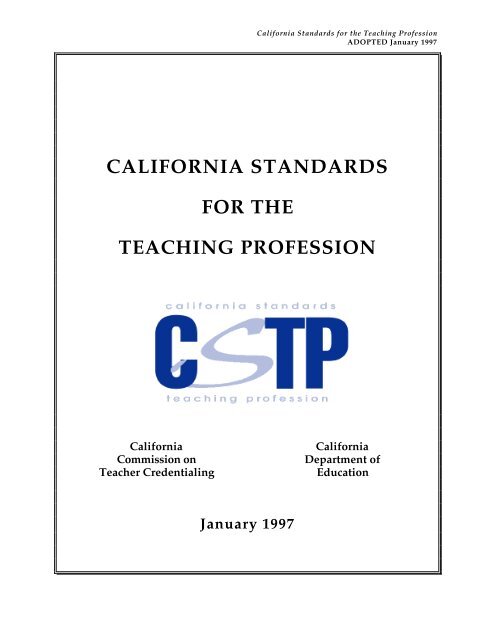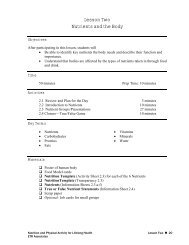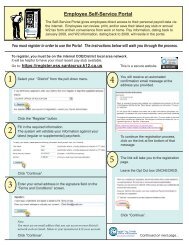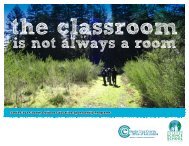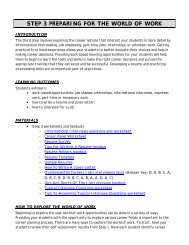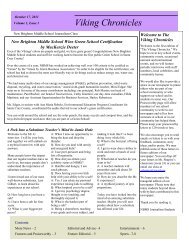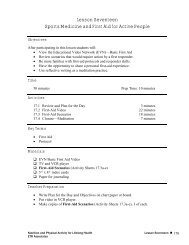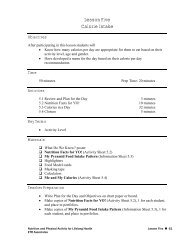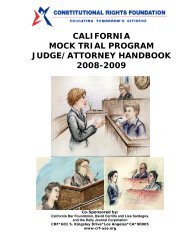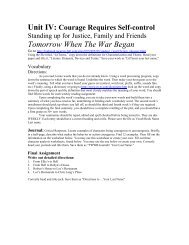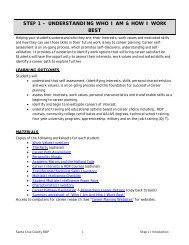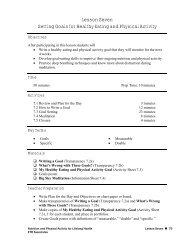California Standards for the Teaching Profession - Commission on ...
California Standards for the Teaching Profession - Commission on ...
California Standards for the Teaching Profession - Commission on ...
Create successful ePaper yourself
Turn your PDF publications into a flip-book with our unique Google optimized e-Paper software.
<str<strong>on</strong>g>Cali<str<strong>on</strong>g>for</str<strong>on</strong>g>nia</str<strong>on</strong>g> <str<strong>on</strong>g>Standards</str<strong>on</strong>g> <str<strong>on</strong>g>for</str<strong>on</strong>g> <str<strong>on</strong>g>the</str<strong>on</strong>g> <str<strong>on</strong>g>Teaching</str<strong>on</strong>g> <str<strong>on</strong>g>Professi<strong>on</strong></str<strong>on</strong>g><br />
ADOPTED January 1997<br />
CALIFORNIA STANDARDS<br />
FOR THE<br />
TEACHING PROFESSION<br />
<str<strong>on</strong>g>Cali<str<strong>on</strong>g>for</str<strong>on</strong>g>nia</str<strong>on</strong>g><br />
<str<strong>on</strong>g>Commissi<strong>on</strong></str<strong>on</strong>g> <strong>on</strong><br />
Teacher Credentialing<br />
<str<strong>on</strong>g>Cali<str<strong>on</strong>g>for</str<strong>on</strong>g>nia</str<strong>on</strong>g><br />
Department of<br />
Educati<strong>on</strong><br />
January 1997
<str<strong>on</strong>g>Cali<str<strong>on</strong>g>for</str<strong>on</strong>g>nia</str<strong>on</strong>g> <str<strong>on</strong>g>Standards</str<strong>on</strong>g> <str<strong>on</strong>g>for</str<strong>on</strong>g> <str<strong>on</strong>g>the</str<strong>on</strong>g> <str<strong>on</strong>g>Teaching</str<strong>on</strong>g> <str<strong>on</strong>g>Professi<strong>on</strong></str<strong>on</strong>g><br />
ADOPTED January 1997<br />
Table of C<strong>on</strong>tents<br />
<str<strong>on</strong>g>Cali<str<strong>on</strong>g>for</str<strong>on</strong>g>nia</str<strong>on</strong>g> <str<strong>on</strong>g>Standards</str<strong>on</strong>g> <str<strong>on</strong>g>for</str<strong>on</strong>g> <str<strong>on</strong>g>the</str<strong>on</strong>g> <str<strong>on</strong>g>Teaching</str<strong>on</strong>g> <str<strong>on</strong>g>Professi<strong>on</strong></str<strong>on</strong>g> 1<br />
Diversity of <str<strong>on</strong>g>Teaching</str<strong>on</strong>g> in <str<strong>on</strong>g>Cali<str<strong>on</strong>g>for</str<strong>on</strong>g>nia</str<strong>on</strong>g> 1<br />
A Holistic Visi<strong>on</strong> of <str<strong>on</strong>g>Teaching</str<strong>on</strong>g> 2<br />
A Developmental View of <str<strong>on</strong>g>Teaching</str<strong>on</strong>g> 2<br />
Organizati<strong>on</strong> of <str<strong>on</strong>g>the</str<strong>on</strong>g> <str<strong>on</strong>g>Cali<str<strong>on</strong>g>for</str<strong>on</strong>g>nia</str<strong>on</strong>g> <str<strong>on</strong>g>Standards</str<strong>on</strong>g> 3<br />
The <str<strong>on</strong>g>Cali<str<strong>on</strong>g>for</str<strong>on</strong>g>nia</str<strong>on</strong>g> <str<strong>on</strong>g>Standards</str<strong>on</strong>g> and Per<str<strong>on</strong>g>for</str<strong>on</strong>g>mance-Based Assessments 4<br />
Page<br />
Standard <str<strong>on</strong>g>for</str<strong>on</strong>g> Engaging and Supporting All Students in Learning 5<br />
Standard <str<strong>on</strong>g>for</str<strong>on</strong>g> Creating and Maintaining Effective Envir<strong>on</strong>ments 8<br />
Standard <str<strong>on</strong>g>for</str<strong>on</strong>g> Understanding and Organizing Subject Matter 11<br />
Standard <str<strong>on</strong>g>for</str<strong>on</strong>g> Planning Instructi<strong>on</strong> and Designing Learning Experiences 14<br />
Standard <str<strong>on</strong>g>for</str<strong>on</strong>g> Assessing Student Learning 17<br />
Standard <str<strong>on</strong>g>for</str<strong>on</strong>g> Developing as a <str<strong>on</strong>g>Professi<strong>on</strong></str<strong>on</strong>g>al Educator 20<br />
Graphic Representati<strong>on</strong> of <str<strong>on</strong>g>the</str<strong>on</strong>g> <str<strong>on</strong>g>Standards</str<strong>on</strong>g> 23<br />
C<strong>on</strong>tributors to <str<strong>on</strong>g>the</str<strong>on</strong>g> <str<strong>on</strong>g>Standards</str<strong>on</strong>g>, Elements and Questi<strong>on</strong>s 31
<str<strong>on</strong>g>Cali<str<strong>on</strong>g>for</str<strong>on</strong>g>nia</str<strong>on</strong>g> <str<strong>on</strong>g>Standards</str<strong>on</strong>g> <str<strong>on</strong>g>for</str<strong>on</strong>g> <str<strong>on</strong>g>the</str<strong>on</strong>g> <str<strong>on</strong>g>Teaching</str<strong>on</strong>g> <str<strong>on</strong>g>Professi<strong>on</strong></str<strong>on</strong>g><br />
ADOPTED January 1997<br />
<str<strong>on</strong>g>Cali<str<strong>on</strong>g>for</str<strong>on</strong>g>nia</str<strong>on</strong>g> <str<strong>on</strong>g>Standards</str<strong>on</strong>g> <str<strong>on</strong>g>for</str<strong>on</strong>g> <str<strong>on</strong>g>the</str<strong>on</strong>g> <str<strong>on</strong>g>Teaching</str<strong>on</strong>g> <str<strong>on</strong>g>Professi<strong>on</strong></str<strong>on</strong>g><br />
Since 1988, <str<strong>on</strong>g>Cali<str<strong>on</strong>g>for</str<strong>on</strong>g>nia</str<strong>on</strong>g> has sought to provide intensive learning experiences <str<strong>on</strong>g>for</str<strong>on</strong>g><br />
beginning teachers. First-year and sec<strong>on</strong>d-year teachers need intensive learning<br />
activities that build <strong>on</strong> <str<strong>on</strong>g>the</str<strong>on</strong>g>ir preservice preparati<strong>on</strong> and lead to lifel<strong>on</strong>g professi<strong>on</strong>al<br />
development. The State's ef<str<strong>on</strong>g>for</str<strong>on</strong>g>ts revealed a need <str<strong>on</strong>g>for</str<strong>on</strong>g> a comm<strong>on</strong> language and a new<br />
visi<strong>on</strong> of <str<strong>on</strong>g>the</str<strong>on</strong>g> scope and complexity of teaching that would enable teachers to define<br />
and develop <str<strong>on</strong>g>the</str<strong>on</strong>g>ir practice. The <str<strong>on</strong>g>Cali<str<strong>on</strong>g>for</str<strong>on</strong>g>nia</str<strong>on</strong>g> <str<strong>on</strong>g>Standards</str<strong>on</strong>g> <str<strong>on</strong>g>for</str<strong>on</strong>g> <str<strong>on</strong>g>the</str<strong>on</strong>g> <str<strong>on</strong>g>Teaching</str<strong>on</strong>g> <str<strong>on</strong>g>Professi<strong>on</strong></str<strong>on</strong>g><br />
address <str<strong>on</strong>g>the</str<strong>on</strong>g>se needs. The <str<strong>on</strong>g>Standards</str<strong>on</strong>g> are designed to be used by teachers to:<br />
• prompt reflecti<strong>on</strong> about student learning and teaching practice;<br />
• <str<strong>on</strong>g>for</str<strong>on</strong>g>mulate professi<strong>on</strong>al goals to improve teaching practice; and<br />
• guide, m<strong>on</strong>itor and assess <str<strong>on</strong>g>the</str<strong>on</strong>g> progress of a teacher's practice<br />
toward professi<strong>on</strong>al goals and professi<strong>on</strong>ally-accepted benchmarks.<br />
The <str<strong>on</strong>g>Standards</str<strong>on</strong>g> address <str<strong>on</strong>g>the</str<strong>on</strong>g> diversity of students and teachers in <str<strong>on</strong>g>Cali<str<strong>on</strong>g>for</str<strong>on</strong>g>nia</str<strong>on</strong>g> schools<br />
today, and <str<strong>on</strong>g>the</str<strong>on</strong>g>y reflect a holistic, developmental view of teaching.<br />
Diversity of <str<strong>on</strong>g>Teaching</str<strong>on</strong>g> in <str<strong>on</strong>g>Cali<str<strong>on</strong>g>for</str<strong>on</strong>g>nia</str<strong>on</strong>g><br />
<str<strong>on</strong>g>Professi<strong>on</strong></str<strong>on</strong>g>al educators in <str<strong>on</strong>g>the</str<strong>on</strong>g> State of <str<strong>on</strong>g>Cali<str<strong>on</strong>g>for</str<strong>on</strong>g>nia</str<strong>on</strong>g> are serving <str<strong>on</strong>g>the</str<strong>on</strong>g> most diverse<br />
populati<strong>on</strong> of students in <str<strong>on</strong>g>the</str<strong>on</strong>g> history of educati<strong>on</strong>. This diversity am<strong>on</strong>g students<br />
can greatly enrich and enliven <str<strong>on</strong>g>the</str<strong>on</strong>g> educati<strong>on</strong>al experience. There is a critical need<br />
<str<strong>on</strong>g>for</str<strong>on</strong>g> teachers who are resp<strong>on</strong>sive to <str<strong>on</strong>g>the</str<strong>on</strong>g> diverse cultural, linguistic and socioec<strong>on</strong>omic<br />
backgrounds of all students. The <str<strong>on</strong>g>Cali<str<strong>on</strong>g>for</str<strong>on</strong>g>nia</str<strong>on</strong>g> <str<strong>on</strong>g>Standards</str<strong>on</strong>g> <str<strong>on</strong>g>for</str<strong>on</strong>g> <str<strong>on</strong>g>the</str<strong>on</strong>g> <str<strong>on</strong>g>Teaching</str<strong>on</strong>g><br />
<str<strong>on</strong>g>Professi<strong>on</strong></str<strong>on</strong>g> support <str<strong>on</strong>g>the</str<strong>on</strong>g> creati<strong>on</strong> of inclusive classrooms in which diverse students of<br />
varying abilities are engaged and challenged as learners. The <str<strong>on</strong>g>Standards</str<strong>on</strong>g> reflect an<br />
expectati<strong>on</strong> that <str<strong>on</strong>g>the</str<strong>on</strong>g> educati<strong>on</strong> of diverse students is likely to be most productive<br />
when teachers use effective pedagogical principles and practices in all subject areas.<br />
The <str<strong>on</strong>g>Standards</str<strong>on</strong>g> also value <str<strong>on</strong>g>the</str<strong>on</strong>g> diversity of teachers' backgrounds, perspectives, skills,<br />
knowledge and practices. <str<strong>on</strong>g>Teaching</str<strong>on</strong>g> is not a professi<strong>on</strong> in which a single approach to<br />
professi<strong>on</strong>al practice will be effective <str<strong>on</strong>g>for</str<strong>on</strong>g> all practiti<strong>on</strong>ers. Although <str<strong>on</strong>g>the</str<strong>on</strong>g> <str<strong>on</strong>g>Standards</str<strong>on</strong>g><br />
articulate a comm<strong>on</strong> visi<strong>on</strong> of excellence in teaching, different teachers have<br />
different ways to fulfill <str<strong>on</strong>g>the</str<strong>on</strong>g> <str<strong>on</strong>g>Standards</str<strong>on</strong>g> effectively. By respecting <str<strong>on</strong>g>the</str<strong>on</strong>g> diverse ways in<br />
which teachers pursue excellence in professi<strong>on</strong>al practice, schools enrich and<br />
enliven <str<strong>on</strong>g>the</str<strong>on</strong>g> educati<strong>on</strong> of diverse students.<br />
Page 1
<str<strong>on</strong>g>Cali<str<strong>on</strong>g>for</str<strong>on</strong>g>nia</str<strong>on</strong>g> <str<strong>on</strong>g>Standards</str<strong>on</strong>g> <str<strong>on</strong>g>for</str<strong>on</strong>g> <str<strong>on</strong>g>the</str<strong>on</strong>g> <str<strong>on</strong>g>Teaching</str<strong>on</strong>g> <str<strong>on</strong>g>Professi<strong>on</strong></str<strong>on</strong>g><br />
ADOPTED January 1997<br />
A Holistic Visi<strong>on</strong> of <str<strong>on</strong>g>Teaching</str<strong>on</strong>g><br />
A holistic view of teaching recognizes that teaching and learning are complex<br />
processes that are interdependent, occur in a variety of c<strong>on</strong>texts, and are affected by<br />
many factors that are intrinsic and external to <str<strong>on</strong>g>the</str<strong>on</strong>g> classroom. A visi<strong>on</strong> of teaching<br />
in <str<strong>on</strong>g>Cali<str<strong>on</strong>g>for</str<strong>on</strong>g>nia</str<strong>on</strong>g> must <str<strong>on</strong>g>the</str<strong>on</strong>g>re<str<strong>on</strong>g>for</str<strong>on</strong>g>e emphasize relati<strong>on</strong>ships between <str<strong>on</strong>g>the</str<strong>on</strong>g> various aspects of<br />
teaching and learning. A teacher's knowledge of students, of subject matter and<br />
curriculum, and of instructi<strong>on</strong>al methods, strategies and styles are ultimately linked<br />
to how <str<strong>on</strong>g>the</str<strong>on</strong>g> teacher plans instructi<strong>on</strong> and creates and assesses opportunities <str<strong>on</strong>g>for</str<strong>on</strong>g><br />
student learning.<br />
<str<strong>on</strong>g>Teaching</str<strong>on</strong>g> is more than methodology. Philosophical and <str<strong>on</strong>g>the</str<strong>on</strong>g>oretical understandings<br />
of teaching and learning empower teachers to make thoughtful, in<str<strong>on</strong>g>for</str<strong>on</strong>g>med decisi<strong>on</strong>s<br />
about instructi<strong>on</strong>al strategies and ways to support students' learning. A teacher's<br />
practice cannot be viewed or evaluated separately from her or his professi<strong>on</strong>al ideas<br />
and understandings; all aspects of teaching are interdependent. The <str<strong>on</strong>g>Standards</str<strong>on</strong>g> are<br />
broad and interdependent because <str<strong>on</strong>g>the</str<strong>on</strong>g> professi<strong>on</strong>al practice of teaching needs to be<br />
seen comprehensively as a complex, dynamic process in which practical and c<strong>on</strong>ceptual<br />
elements are woven toge<str<strong>on</strong>g>the</str<strong>on</strong>g>r as a seamless fabric.<br />
A Developmental View of <str<strong>on</strong>g>Teaching</str<strong>on</strong>g><br />
Teachers' knowledge, skills and practices develop throughout <str<strong>on</strong>g>the</str<strong>on</strong>g>ir professi<strong>on</strong>al<br />
careers. The nature of teaching requires c<strong>on</strong>tinuous growth in order to engage and<br />
challenge increasingly diverse students in a rapidly changing world. Teachers are<br />
never "finished" as professi<strong>on</strong>al learners, no matter how extensive or excellent<br />
<str<strong>on</strong>g>the</str<strong>on</strong>g>ir <str<strong>on</strong>g>for</str<strong>on</strong>g>mal educati<strong>on</strong> and preparati<strong>on</strong>. If teachers' expertise, capabilities, and<br />
accomplishments are to be enriched over time, <str<strong>on</strong>g>the</str<strong>on</strong>g> teachers must become reflective<br />
practiti<strong>on</strong>ers who actively seek to streng<str<strong>on</strong>g>the</str<strong>on</strong>g>n and augment <str<strong>on</strong>g>the</str<strong>on</strong>g>ir professi<strong>on</strong>al skills,<br />
knowledge and perspectives throughout <str<strong>on</strong>g>the</str<strong>on</strong>g>ir careers.<br />
A developmental view of teaching gives particular attenti<strong>on</strong> to <str<strong>on</strong>g>the</str<strong>on</strong>g> early years of<br />
each teacher's career. Individual teachers enter <str<strong>on</strong>g>the</str<strong>on</strong>g> professi<strong>on</strong> at varied levels of<br />
experience and expertise. New teachers may move <str<strong>on</strong>g>for</str<strong>on</strong>g>ward in <str<strong>on</strong>g>the</str<strong>on</strong>g>ir professi<strong>on</strong>al<br />
practice in a variety of ways, developing at different rates in different areas of<br />
teaching, just as students develop at individual rates in different curricular areas as<br />
a result of varied life experiences and perspectives. Support, mentoring, and<br />
assessment during <str<strong>on</strong>g>the</str<strong>on</strong>g> early years of teaching are essential to a beginning teacher's<br />
development and success in <str<strong>on</strong>g>the</str<strong>on</strong>g> professi<strong>on</strong>.<br />
The policies and practices of teacher educati<strong>on</strong> programs, certificati<strong>on</strong> bodies, and<br />
schools must be guided by clear and realistic standards regarding professi<strong>on</strong>al<br />
per<str<strong>on</strong>g>for</str<strong>on</strong>g>mance. The <str<strong>on</strong>g>Cali<str<strong>on</strong>g>for</str<strong>on</strong>g>nia</str<strong>on</strong>g> <str<strong>on</strong>g>Standards</str<strong>on</strong>g> <str<strong>on</strong>g>for</str<strong>on</strong>g> <str<strong>on</strong>g>the</str<strong>on</strong>g> <str<strong>on</strong>g>Teaching</str<strong>on</strong>g> <str<strong>on</strong>g>Professi<strong>on</strong></str<strong>on</strong>g> incorporate and<br />
in<str<strong>on</strong>g>for</str<strong>on</strong>g>m a developmental view of teaching, and are an integral part of <str<strong>on</strong>g>the</str<strong>on</strong>g> State's<br />
ef<str<strong>on</strong>g>for</str<strong>on</strong>g>ts to foster excellence in teaching and learning.<br />
Page 2
<str<strong>on</strong>g>Cali<str<strong>on</strong>g>for</str<strong>on</strong>g>nia</str<strong>on</strong>g> <str<strong>on</strong>g>Standards</str<strong>on</strong>g> <str<strong>on</strong>g>for</str<strong>on</strong>g> <str<strong>on</strong>g>the</str<strong>on</strong>g> <str<strong>on</strong>g>Teaching</str<strong>on</strong>g> <str<strong>on</strong>g>Professi<strong>on</strong></str<strong>on</strong>g><br />
ADOPTED January 1997<br />
Organizati<strong>on</strong> of <str<strong>on</strong>g>the</str<strong>on</strong>g> <str<strong>on</strong>g>Cali<str<strong>on</strong>g>for</str<strong>on</strong>g>nia</str<strong>on</strong>g> <str<strong>on</strong>g>Standards</str<strong>on</strong>g><br />
The <str<strong>on</strong>g>Cali<str<strong>on</strong>g>for</str<strong>on</strong>g>nia</str<strong>on</strong>g> <str<strong>on</strong>g>Standards</str<strong>on</strong>g> <str<strong>on</strong>g>for</str<strong>on</strong>g> <str<strong>on</strong>g>the</str<strong>on</strong>g> <str<strong>on</strong>g>Teaching</str<strong>on</strong>g> <str<strong>on</strong>g>Professi<strong>on</strong></str<strong>on</strong>g> are based <strong>on</strong> current research<br />
and expert advice pertaining to best teaching practice. The <str<strong>on</strong>g>Standards</str<strong>on</strong>g> are organized<br />
around six interrelated categories of teaching practice. The six standards are <str<strong>on</strong>g>for</str<strong>on</strong>g>:<br />
• Engaging and Supporting All Students in Learning<br />
• Creating and Maintaining Effective Envir<strong>on</strong>ments <str<strong>on</strong>g>for</str<strong>on</strong>g> Student Learning<br />
• Understanding and Organizing Subject Matter <str<strong>on</strong>g>for</str<strong>on</strong>g> Student Learning<br />
• Planning Instructi<strong>on</strong> and Designing Learning Experiences <str<strong>on</strong>g>for</str<strong>on</strong>g> All Students<br />
• Assessing Student Learning<br />
• Developing as a <str<strong>on</strong>g>Professi<strong>on</strong></str<strong>on</strong>g>al Educator<br />
Toge<str<strong>on</strong>g>the</str<strong>on</strong>g>r <str<strong>on</strong>g>the</str<strong>on</strong>g>se six standards represent a developmental, holistic view of teaching,<br />
and are intended to meet <str<strong>on</strong>g>the</str<strong>on</strong>g> needs of diverse teachers and students in <str<strong>on</strong>g>Cali<str<strong>on</strong>g>for</str<strong>on</strong>g>nia</str<strong>on</strong>g>.<br />
In <str<strong>on</strong>g>the</str<strong>on</strong>g> following pages, each standard is introduced in a narrative descripti<strong>on</strong> of best<br />
practice that portrays an accomplished level of teaching. Following <str<strong>on</strong>g>the</str<strong>on</strong>g> narrative<br />
descripti<strong>on</strong>, each standard is organized in elements that identify key areas within<br />
that domain of teaching. Each element is fur<str<strong>on</strong>g>the</str<strong>on</strong>g>r specified with questi<strong>on</strong>s that<br />
encourage teachers to explore aspects of teaching practice throughout <str<strong>on</strong>g>the</str<strong>on</strong>g>ir careers.<br />
In order to foster <strong>on</strong>going reflecti<strong>on</strong> and insights into teaching, <str<strong>on</strong>g>the</str<strong>on</strong>g> questi<strong>on</strong>s are<br />
introduced with <str<strong>on</strong>g>the</str<strong>on</strong>g> stem, "How do I . . ." The questi<strong>on</strong>s can also be phrased as<br />
"Why do I . . ," which encourages teachers to examine <str<strong>on</strong>g>the</str<strong>on</strong>g> rati<strong>on</strong>ale <str<strong>on</strong>g>for</str<strong>on</strong>g> key aspects of<br />
<str<strong>on</strong>g>the</str<strong>on</strong>g>ir teaching.<br />
Within each element, <str<strong>on</strong>g>the</str<strong>on</strong>g> questi<strong>on</strong>s address <strong>on</strong>ly a sample of <str<strong>on</strong>g>the</str<strong>on</strong>g> important facets of<br />
teaching, and do not represent all <str<strong>on</strong>g>the</str<strong>on</strong>g> possible issues or aspects of teaching.<br />
There<str<strong>on</strong>g>for</str<strong>on</strong>g>e, <str<strong>on</strong>g>the</str<strong>on</strong>g> questi<strong>on</strong>s should not be used as checklists, but ra<str<strong>on</strong>g>the</str<strong>on</strong>g>r as probing<br />
issues to promote reflecti<strong>on</strong> and professi<strong>on</strong>al development throughout <strong>on</strong>e's career.<br />
Teachers using <str<strong>on</strong>g>the</str<strong>on</strong>g> <str<strong>on</strong>g>Cali<str<strong>on</strong>g>for</str<strong>on</strong>g>nia</str<strong>on</strong>g> <str<strong>on</strong>g>Standards</str<strong>on</strong>g> will recognize that <str<strong>on</strong>g>the</str<strong>on</strong>g>re are some overlaps<br />
between and am<strong>on</strong>g <str<strong>on</strong>g>the</str<strong>on</strong>g> six standards, elements, and questi<strong>on</strong>s. These overlaps are<br />
intended to underscore <str<strong>on</strong>g>the</str<strong>on</strong>g> holistic view that emphasizes <str<strong>on</strong>g>the</str<strong>on</strong>g> interrelati<strong>on</strong>ships and<br />
complexities of teaching. For example, valuing and drawing <strong>on</strong> student backgrounds<br />
and experiences are integral aspects of all six <str<strong>on</strong>g>Standards</str<strong>on</strong>g>.<br />
Page 3
<str<strong>on</strong>g>Cali<str<strong>on</strong>g>for</str<strong>on</strong>g>nia</str<strong>on</strong>g> <str<strong>on</strong>g>Standards</str<strong>on</strong>g> <str<strong>on</strong>g>for</str<strong>on</strong>g> <str<strong>on</strong>g>the</str<strong>on</strong>g> <str<strong>on</strong>g>Teaching</str<strong>on</strong>g> <str<strong>on</strong>g>Professi<strong>on</strong></str<strong>on</strong>g><br />
ADOPTED January 1997<br />
The <str<strong>on</strong>g>Cali<str<strong>on</strong>g>for</str<strong>on</strong>g>nia</str<strong>on</strong>g> <str<strong>on</strong>g>Standards</str<strong>on</strong>g> and Per<str<strong>on</strong>g>for</str<strong>on</strong>g>mance-Based Assessments<br />
The <str<strong>on</strong>g>Cali<str<strong>on</strong>g>for</str<strong>on</strong>g>nia</str<strong>on</strong>g> <str<strong>on</strong>g>Commissi<strong>on</strong></str<strong>on</strong>g> <strong>on</strong> Teacher Credentialing and <str<strong>on</strong>g>the</str<strong>on</strong>g> Department of<br />
Educati<strong>on</strong> are pursuing ways to make <str<strong>on</strong>g>the</str<strong>on</strong>g> <str<strong>on</strong>g>Cali<str<strong>on</strong>g>for</str<strong>on</strong>g>nia</str<strong>on</strong>g> <str<strong>on</strong>g>Standards</str<strong>on</strong>g> as valuable and<br />
useful as possible <str<strong>on</strong>g>for</str<strong>on</strong>g> teachers. The two agencies are sp<strong>on</strong>soring <str<strong>on</strong>g>the</str<strong>on</strong>g> preparati<strong>on</strong> of<br />
Developmental Scales that will make it possible <str<strong>on</strong>g>for</str<strong>on</strong>g> teachers to obtain accurate,<br />
reliable in<str<strong>on</strong>g>for</str<strong>on</strong>g>mati<strong>on</strong> about <str<strong>on</strong>g>the</str<strong>on</strong>g>ir developmental levels in relati<strong>on</strong> to each standard.<br />
Future publicati<strong>on</strong>s of <str<strong>on</strong>g>the</str<strong>on</strong>g> <str<strong>on</strong>g>Cali<str<strong>on</strong>g>for</str<strong>on</strong>g>nia</str<strong>on</strong>g> <str<strong>on</strong>g>Standards</str<strong>on</strong>g> will include <str<strong>on</strong>g>the</str<strong>on</strong>g> anticipated<br />
Developmental Scales.<br />
The Department and <str<strong>on</strong>g>the</str<strong>on</strong>g> <str<strong>on</strong>g>Commissi<strong>on</strong></str<strong>on</strong>g> are also using <str<strong>on</strong>g>the</str<strong>on</strong>g> <str<strong>on</strong>g>Cali<str<strong>on</strong>g>for</str<strong>on</strong>g>nia</str<strong>on</strong>g> <str<strong>on</strong>g>Standards</str<strong>on</strong>g> to<br />
guide <str<strong>on</strong>g>the</str<strong>on</strong>g> design of Formative Assessments that support teachers' professi<strong>on</strong>al<br />
growth during <str<strong>on</strong>g>the</str<strong>on</strong>g> "inducti<strong>on</strong> period" and throughout <str<strong>on</strong>g>the</str<strong>on</strong>g> teaching career. The<br />
holistic, developmental perspective of teaching promotes <str<strong>on</strong>g>the</str<strong>on</strong>g> use of per<str<strong>on</strong>g>for</str<strong>on</strong>g>mancebased<br />
assessments such as portfolios and observati<strong>on</strong> criteria like those being piloted<br />
in <str<strong>on</strong>g>the</str<strong>on</strong>g> Beginning Teacher Support and Assessment (BTSA) Program. Once <str<strong>on</strong>g>the</str<strong>on</strong>g><br />
Developmental Scales and Formative Assessments are completed, teachers will, in<br />
<str<strong>on</strong>g>the</str<strong>on</strong>g>ir pursuit of excellence in teaching practice and student learning, be able to derive<br />
maximum benefit from <str<strong>on</strong>g>the</str<strong>on</strong>g> <str<strong>on</strong>g>Cali<str<strong>on</strong>g>for</str<strong>on</strong>g>nia</str<strong>on</strong>g> <str<strong>on</strong>g>Standards</str<strong>on</strong>g> <str<strong>on</strong>g>for</str<strong>on</strong>g> <str<strong>on</strong>g>the</str<strong>on</strong>g> <str<strong>on</strong>g>Teaching</str<strong>on</strong>g> <str<strong>on</strong>g>Professi<strong>on</strong></str<strong>on</strong>g>.<br />
Page 4
<str<strong>on</strong>g>Cali<str<strong>on</strong>g>for</str<strong>on</strong>g>nia</str<strong>on</strong>g> <str<strong>on</strong>g>Standards</str<strong>on</strong>g> <str<strong>on</strong>g>for</str<strong>on</strong>g> <str<strong>on</strong>g>the</str<strong>on</strong>g> <str<strong>on</strong>g>Teaching</str<strong>on</strong>g> <str<strong>on</strong>g>Professi<strong>on</strong></str<strong>on</strong>g><br />
ADOPTED January 1997<br />
STANDARD FOR<br />
ENGAGING AND SUPPORTING ALL STUDENTS IN LEARNING<br />
Teachers build <strong>on</strong> students' prior knowledge, life experience, and interests to<br />
achieve learning goals <str<strong>on</strong>g>for</str<strong>on</strong>g> all students. Teachers use a variety of instructi<strong>on</strong>al<br />
strategies and resources that resp<strong>on</strong>d to students' diverse needs. Teachers facilitate<br />
challenging learning experiences <str<strong>on</strong>g>for</str<strong>on</strong>g> all students in envir<strong>on</strong>ments that promote<br />
aut<strong>on</strong>omy, interacti<strong>on</strong> and choice. Teachers actively engage all students in<br />
problem solving and critical thinking within and across subject matter areas.<br />
C<strong>on</strong>cepts and skills are taught in ways that encourage students to apply <str<strong>on</strong>g>the</str<strong>on</strong>g>m in<br />
real-life c<strong>on</strong>texts that make subject matter meaningful. Teachers assist all students<br />
to become self-directed learners who are able to dem<strong>on</strong>strate, articulate, and<br />
evaluate what <str<strong>on</strong>g>the</str<strong>on</strong>g>y learn.<br />
Key Element: C<strong>on</strong>necting students' prior knowledge, life experience, and interests<br />
with learning goals.<br />
As teachers develop, <str<strong>on</strong>g>the</str<strong>on</strong>g>y may ask, "How do I . . ." or "Why do I . . ."<br />
• help students to see <str<strong>on</strong>g>the</str<strong>on</strong>g> c<strong>on</strong>necti<strong>on</strong>s between what <str<strong>on</strong>g>the</str<strong>on</strong>g>y already know and <str<strong>on</strong>g>the</str<strong>on</strong>g> new material<br />
• help students to c<strong>on</strong>nect classroom learning to <str<strong>on</strong>g>the</str<strong>on</strong>g>ir life experiences and cultural understandings<br />
• support all students to use first and sec<strong>on</strong>d language skills to achieve learning goals<br />
• open a less<strong>on</strong> or unit to capture student attenti<strong>on</strong> and interest<br />
• build <strong>on</strong> students' comments and questi<strong>on</strong>s during a less<strong>on</strong> to extend <str<strong>on</strong>g>the</str<strong>on</strong>g>ir understanding<br />
• make "<strong>on</strong> <str<strong>on</strong>g>the</str<strong>on</strong>g> spot" changes in my teaching based <strong>on</strong> students' interests and questi<strong>on</strong>s<br />
Key Element: Using a variety of instructi<strong>on</strong>al strategies and resources to resp<strong>on</strong>d to<br />
students' diverse needs.<br />
As teachers develop, <str<strong>on</strong>g>the</str<strong>on</strong>g>y may ask, "How do I . . ." or "Why do I . . ."<br />
• engage all students in a variety of learning experiences that accommodate <str<strong>on</strong>g>the</str<strong>on</strong>g> different ways<br />
<str<strong>on</strong>g>the</str<strong>on</strong>g>y learn<br />
Page 5
<str<strong>on</strong>g>Cali<str<strong>on</strong>g>for</str<strong>on</strong>g>nia</str<strong>on</strong>g> <str<strong>on</strong>g>Standards</str<strong>on</strong>g> <str<strong>on</strong>g>for</str<strong>on</strong>g> <str<strong>on</strong>g>the</str<strong>on</strong>g> <str<strong>on</strong>g>Teaching</str<strong>on</strong>g> <str<strong>on</strong>g>Professi<strong>on</strong></str<strong>on</strong>g><br />
ADOPTED January 1997<br />
• use a variety of strategies to introduce, explain, and restate subject matter c<strong>on</strong>cepts and<br />
processes so that all students understand<br />
• choose strategies that make <str<strong>on</strong>g>the</str<strong>on</strong>g> complexity and depth of subject matter understandable to all<br />
students<br />
• use strategies that support subject matter learning <str<strong>on</strong>g>for</str<strong>on</strong>g> sec<strong>on</strong>d language learners<br />
• modify materials and resources and use appropriate adaptive equipment to support each<br />
student's fullest participati<strong>on</strong><br />
• use technology to enhance student learning<br />
• vary my instructi<strong>on</strong>al strategies to increase students' active participati<strong>on</strong> in learning<br />
• ask questi<strong>on</strong>s or facilitate discussi<strong>on</strong> to clarify or extend students' thinking<br />
• make use of unexpected events to augment student learning<br />
• recognize when a less<strong>on</strong> is falling apart and what do I do about it<br />
Key Element: Facilitating learning experiences that promote aut<strong>on</strong>omy, interacti<strong>on</strong>,<br />
and choice.<br />
As teachers develop, <str<strong>on</strong>g>the</str<strong>on</strong>g>y may ask, "How do I . . ." or "Why do I . . ."<br />
• use <str<strong>on</strong>g>the</str<strong>on</strong>g> classroom envir<strong>on</strong>ment to provide opportunities <str<strong>on</strong>g>for</str<strong>on</strong>g> independent and collaborative<br />
learning<br />
• provide a variety of grouping structures to promote student interacti<strong>on</strong>s and learning<br />
• participate in and promote positive interacti<strong>on</strong>s between all students<br />
• support and m<strong>on</strong>itor student aut<strong>on</strong>omy and choice during learning experiences<br />
• support and m<strong>on</strong>itor student collaborati<strong>on</strong> during learning activities<br />
• help students make decisi<strong>on</strong>s about managing time and materials during learning activities<br />
Key Element: Engaging students in problem solving, critical thinking and o<str<strong>on</strong>g>the</str<strong>on</strong>g>r<br />
activities that make subject matter meaningful.<br />
As teachers develop, <str<strong>on</strong>g>the</str<strong>on</strong>g>y may ask, "How do I . . ." or "Why do I . . ."<br />
• provide opportunities <str<strong>on</strong>g>for</str<strong>on</strong>g> all students to think, discuss, interact, reflect and evaluate c<strong>on</strong>tent<br />
• help all students to learn, practice, internalize and apply subject-specific learning strategies<br />
and procedures<br />
Page 6
<str<strong>on</strong>g>Cali<str<strong>on</strong>g>for</str<strong>on</strong>g>nia</str<strong>on</strong>g> <str<strong>on</strong>g>Standards</str<strong>on</strong>g> <str<strong>on</strong>g>for</str<strong>on</strong>g> <str<strong>on</strong>g>the</str<strong>on</strong>g> <str<strong>on</strong>g>Teaching</str<strong>on</strong>g> <str<strong>on</strong>g>Professi<strong>on</strong></str<strong>on</strong>g><br />
ADOPTED January 1997<br />
• support all students in critically investigating subject matter c<strong>on</strong>cepts and questi<strong>on</strong>s<br />
• engage all students in problem solving activities and encourage multiple approaches and<br />
soluti<strong>on</strong>s<br />
• encourage all students to ask critical questi<strong>on</strong>s and c<strong>on</strong>sider diverse perspectives about subject<br />
matter<br />
• provide opportunities <str<strong>on</strong>g>for</str<strong>on</strong>g> all students to learn and practice skills in meaningful c<strong>on</strong>texts<br />
• help all students to analyze and draw valid c<strong>on</strong>clusi<strong>on</strong>s about c<strong>on</strong>tent being learned<br />
Key Element: Promoting self-directed, reflective learning <str<strong>on</strong>g>for</str<strong>on</strong>g> all students.<br />
As teachers develop, <str<strong>on</strong>g>the</str<strong>on</strong>g>y may ask, "How do I . . ." or "Why do I . . ."<br />
• motivate all students to initiate <str<strong>on</strong>g>the</str<strong>on</strong>g>ir own learning and to strive <str<strong>on</strong>g>for</str<strong>on</strong>g> challenging learning<br />
goals<br />
• encourage all students to describe <str<strong>on</strong>g>the</str<strong>on</strong>g>ir own learning processes and progress<br />
• explain clear learning goals <str<strong>on</strong>g>for</str<strong>on</strong>g> all students of each activity or less<strong>on</strong><br />
• engage all students in opportunities to examine and evaluate <str<strong>on</strong>g>the</str<strong>on</strong>g>ir own work and to learn from<br />
<str<strong>on</strong>g>the</str<strong>on</strong>g> work of <str<strong>on</strong>g>the</str<strong>on</strong>g>ir peers<br />
• help all students to develop and use strategies <str<strong>on</strong>g>for</str<strong>on</strong>g> knowing about, reflecting <strong>on</strong>, and m<strong>on</strong>itoring<br />
<str<strong>on</strong>g>the</str<strong>on</strong>g>ir own learning<br />
• help all students to develop and use strategies <str<strong>on</strong>g>for</str<strong>on</strong>g> accessing knowledge and in<str<strong>on</strong>g>for</str<strong>on</strong>g>mati<strong>on</strong><br />
Page 7
<str<strong>on</strong>g>Cali<str<strong>on</strong>g>for</str<strong>on</strong>g>nia</str<strong>on</strong>g> <str<strong>on</strong>g>Standards</str<strong>on</strong>g> <str<strong>on</strong>g>for</str<strong>on</strong>g> <str<strong>on</strong>g>the</str<strong>on</strong>g> <str<strong>on</strong>g>Teaching</str<strong>on</strong>g> <str<strong>on</strong>g>Professi<strong>on</strong></str<strong>on</strong>g><br />
ADOPTED January 1997<br />
STANDARD FOR<br />
CREATING AND MAINTAINING<br />
EFFECTIVE ENVIRONMENTS FOR STUDENT LEARNING<br />
Teachers create physical envir<strong>on</strong>ments that engage all students in purposeful<br />
learning activities and encourage c<strong>on</strong>structive interacti<strong>on</strong>s am<strong>on</strong>g students.<br />
Teachers maintain safe learning envir<strong>on</strong>ments in which all students are treated<br />
fairly and respectfully as <str<strong>on</strong>g>the</str<strong>on</strong>g>y assume resp<strong>on</strong>sibility <str<strong>on</strong>g>for</str<strong>on</strong>g> <str<strong>on</strong>g>the</str<strong>on</strong>g>mselves and <strong>on</strong>e<br />
ano<str<strong>on</strong>g>the</str<strong>on</strong>g>r. Teachers encourage all students to participate in making decisi<strong>on</strong>s and<br />
in working independently and collaboratively. Expectati<strong>on</strong>s <str<strong>on</strong>g>for</str<strong>on</strong>g> student behavior<br />
are established early, clearly understood, and c<strong>on</strong>sistently maintained. Teachers<br />
make effective use of instructi<strong>on</strong>al time as <str<strong>on</strong>g>the</str<strong>on</strong>g>y implement class procedures and<br />
routines.<br />
Key Element: Creating a physical envir<strong>on</strong>ment that engages all students.<br />
As teachers develop, <str<strong>on</strong>g>the</str<strong>on</strong>g>y may ask, "How do I . . ." or "Why do I . . ."<br />
• arrange <str<strong>on</strong>g>the</str<strong>on</strong>g> room to facilitate positive classroom interacti<strong>on</strong>s<br />
• arrange and adapt classroom seating to accommodate individual and group learning needs<br />
• manage student and teacher access to materials, technology, and resources to promote learning<br />
• create a classroom envir<strong>on</strong>ment that reflects and promotes student learning<br />
• make <str<strong>on</strong>g>the</str<strong>on</strong>g> classroom envir<strong>on</strong>ment safe and accessible <str<strong>on</strong>g>for</str<strong>on</strong>g> all students<br />
Key Element: Establishing a climate that promotes fairness and respect.<br />
As teachers develop, <str<strong>on</strong>g>the</str<strong>on</strong>g>y may ask, "How do I . . ." or "Why do I . . ."<br />
• help all students become respectful of o<str<strong>on</strong>g>the</str<strong>on</strong>g>rs who may be different from <str<strong>on</strong>g>the</str<strong>on</strong>g>m<br />
• model and promote fairness, equity, and respect in <str<strong>on</strong>g>the</str<strong>on</strong>g> classroom<br />
• encourage, support, and recognize <str<strong>on</strong>g>the</str<strong>on</strong>g> achievements and c<strong>on</strong>tributi<strong>on</strong>s of all students<br />
• encourage students to take risks and be creative<br />
• understand and resp<strong>on</strong>d to inappropriate behaviors in a fair, equitable way<br />
Page 8
<str<strong>on</strong>g>Cali<str<strong>on</strong>g>for</str<strong>on</strong>g>nia</str<strong>on</strong>g> <str<strong>on</strong>g>Standards</str<strong>on</strong>g> <str<strong>on</strong>g>for</str<strong>on</strong>g> <str<strong>on</strong>g>the</str<strong>on</strong>g> <str<strong>on</strong>g>Teaching</str<strong>on</strong>g> <str<strong>on</strong>g>Professi<strong>on</strong></str<strong>on</strong>g><br />
ADOPTED January 1997<br />
Key Element: Promoting social development and group resp<strong>on</strong>sibility.<br />
As teachers develop, <str<strong>on</strong>g>the</str<strong>on</strong>g>y may ask, "How do I . . ." or "Why do I . . ."<br />
• help all students accept and respect different experiences, ideas, backgrounds, feelings, and<br />
points of view<br />
• group students to promote social development and learning<br />
• facilitate <str<strong>on</strong>g>the</str<strong>on</strong>g> development of each student's self esteem<br />
• create opportunities <str<strong>on</strong>g>for</str<strong>on</strong>g> all students to communicate and work with <strong>on</strong>e ano<str<strong>on</strong>g>the</str<strong>on</strong>g>r<br />
• teach leadership skills and provide opportunities <str<strong>on</strong>g>for</str<strong>on</strong>g> all students to use <str<strong>on</strong>g>the</str<strong>on</strong>g>m<br />
• use classroom rules to support all students in assuming resp<strong>on</strong>sibility <str<strong>on</strong>g>for</str<strong>on</strong>g> <str<strong>on</strong>g>the</str<strong>on</strong>g>mselves and <strong>on</strong>e<br />
ano<str<strong>on</strong>g>the</str<strong>on</strong>g>r<br />
• create opportunities <str<strong>on</strong>g>for</str<strong>on</strong>g> all students to become self-directed learners<br />
Key Element: Establishing and maintaining standards <str<strong>on</strong>g>for</str<strong>on</strong>g> student behavior.<br />
As teachers develop, <str<strong>on</strong>g>the</str<strong>on</strong>g>y may ask, "How do I . . ." or "Why do I . . ."<br />
• understand <str<strong>on</strong>g>the</str<strong>on</strong>g> reas<strong>on</strong>s <str<strong>on</strong>g>for</str<strong>on</strong>g> student behavior<br />
• establish and c<strong>on</strong>sistently maintain standards <str<strong>on</strong>g>for</str<strong>on</strong>g> behavior that reflect my students'<br />
developmental and pers<strong>on</strong>al needs<br />
• intervene when student behavior does not meet agreed-up<strong>on</strong> classroom standards<br />
• facilitate student participati<strong>on</strong> in classroom decisi<strong>on</strong>-making<br />
• help all students learn to solve problems and resolve c<strong>on</strong>flicts<br />
• support all students as <str<strong>on</strong>g>the</str<strong>on</strong>g>y develop resp<strong>on</strong>sibility <str<strong>on</strong>g>for</str<strong>on</strong>g> <str<strong>on</strong>g>the</str<strong>on</strong>g>ir own behavior<br />
• work collaboratively with families to maintain standards <str<strong>on</strong>g>for</str<strong>on</strong>g> student behavior<br />
Page 9
<str<strong>on</strong>g>Cali<str<strong>on</strong>g>for</str<strong>on</strong>g>nia</str<strong>on</strong>g> <str<strong>on</strong>g>Standards</str<strong>on</strong>g> <str<strong>on</strong>g>for</str<strong>on</strong>g> <str<strong>on</strong>g>the</str<strong>on</strong>g> <str<strong>on</strong>g>Teaching</str<strong>on</strong>g> <str<strong>on</strong>g>Professi<strong>on</strong></str<strong>on</strong>g><br />
ADOPTED January 1997<br />
Key Element: Planning and implementing classroom procedures and routines<br />
that support student learning.<br />
As teachers develop, <str<strong>on</strong>g>the</str<strong>on</strong>g>y may ask, "How do I . . ." or "Why do I . . ."<br />
• develop a daily schedule, timelines, classroom routines, and classroom rules<br />
• involve all students in <str<strong>on</strong>g>the</str<strong>on</strong>g> development of classroom procedures and routines<br />
• support students to internalize classroom rules, routines, and procedures and to become selfdirected<br />
learners<br />
• develop classroom procedures and routines that promote and maintain a climate of fairness and<br />
respect<br />
• make decisi<strong>on</strong>s about modifying procedures and rules to support student learning<br />
Key Element: Using instructi<strong>on</strong>al time effectively.<br />
As teachers develop, <str<strong>on</strong>g>the</str<strong>on</strong>g>y may ask, "How do I . . ." or "Why do I . . ."<br />
• structure time with students to support <str<strong>on</strong>g>the</str<strong>on</strong>g>ir learning<br />
• help students move from <strong>on</strong>e instructi<strong>on</strong>al activity to <str<strong>on</strong>g>the</str<strong>on</strong>g> next<br />
• pace and adjust instructi<strong>on</strong>al time so that all students remain engaged<br />
• redirect student behavior in <str<strong>on</strong>g>the</str<strong>on</strong>g> most productive and time effective way<br />
• ensure that adequate time is provided <str<strong>on</strong>g>for</str<strong>on</strong>g> all students to complete learning activities<br />
• provide time <str<strong>on</strong>g>for</str<strong>on</strong>g> all students to reflect <strong>on</strong> <str<strong>on</strong>g>the</str<strong>on</strong>g>ir learning and process of instructi<strong>on</strong><br />
• structure time <str<strong>on</strong>g>for</str<strong>on</strong>g> day to day managerial and administrative tasks<br />
Page 10
<str<strong>on</strong>g>Cali<str<strong>on</strong>g>for</str<strong>on</strong>g>nia</str<strong>on</strong>g> <str<strong>on</strong>g>Standards</str<strong>on</strong>g> <str<strong>on</strong>g>for</str<strong>on</strong>g> <str<strong>on</strong>g>the</str<strong>on</strong>g> <str<strong>on</strong>g>Teaching</str<strong>on</strong>g> <str<strong>on</strong>g>Professi<strong>on</strong></str<strong>on</strong>g><br />
ADOPTED January 1997<br />
STANDARD FOR<br />
UNDERSTANDING AND ORGANIZING<br />
SUBJECT MATTER FOR STUDENT LEARNING<br />
Teachers exhibit str<strong>on</strong>g working knowledge of subject matter and student<br />
development. Teachers organize curriculum to facilitate students' understanding<br />
of <str<strong>on</strong>g>the</str<strong>on</strong>g> central <str<strong>on</strong>g>the</str<strong>on</strong>g>mes, c<strong>on</strong>cepts, and skills in <str<strong>on</strong>g>the</str<strong>on</strong>g> subject area. Teachers interrelate<br />
ideas and in<str<strong>on</strong>g>for</str<strong>on</strong>g>mati<strong>on</strong> within and across curricular areas to extend students'<br />
understanding. Teachers use <str<strong>on</strong>g>the</str<strong>on</strong>g>ir knowledge of student development, subject<br />
matter, instructi<strong>on</strong>al resources and teaching strategies to make subject matter<br />
accessible to all students.<br />
Key Element: Dem<strong>on</strong>strating knowledge of subject matter c<strong>on</strong>tent and student<br />
development.<br />
As teachers develop, <str<strong>on</strong>g>the</str<strong>on</strong>g>y may ask, "How do I . . ." or "Why do I . . ."<br />
• identify and understand <str<strong>on</strong>g>the</str<strong>on</strong>g> key c<strong>on</strong>cepts and underlying <str<strong>on</strong>g>the</str<strong>on</strong>g>mes and relati<strong>on</strong>ships in <str<strong>on</strong>g>the</str<strong>on</strong>g><br />
subject area(s) to be taught<br />
• ensure that my knowledge of <str<strong>on</strong>g>the</str<strong>on</strong>g> subject matter incorporates different perspectives<br />
• c<strong>on</strong>tinue to keep my subject matter knowledge current <br />
• ensure that my subject matter knowledge is sufficient to support student learning<br />
• build understanding of my students’ cognitive and linguistic development<br />
• build understanding of my students’ social, emoti<strong>on</strong>al, and physical development<br />
Key Element: Organizing curriculum to support student understanding of subject<br />
matter.<br />
As teachers develop, <str<strong>on</strong>g>the</str<strong>on</strong>g>y may ask, "How do I . . ." or "Why do I . . ."<br />
• use my knowledge of development to organize and sequence <str<strong>on</strong>g>the</str<strong>on</strong>g> curriculum to increase student<br />
understanding<br />
• use my subject matter knowledge to organize and sequence <str<strong>on</strong>g>the</str<strong>on</strong>g> curriculum to increase student<br />
understanding<br />
Page 11
<str<strong>on</strong>g>Cali<str<strong>on</strong>g>for</str<strong>on</strong>g>nia</str<strong>on</strong>g> <str<strong>on</strong>g>Standards</str<strong>on</strong>g> <str<strong>on</strong>g>for</str<strong>on</strong>g> <str<strong>on</strong>g>the</str<strong>on</strong>g> <str<strong>on</strong>g>Teaching</str<strong>on</strong>g> <str<strong>on</strong>g>Professi<strong>on</strong></str<strong>on</strong>g><br />
ADOPTED January 1997<br />
• use my knowledge of <str<strong>on</strong>g>the</str<strong>on</strong>g> subject to plan units and instructi<strong>on</strong>al activities that dem<strong>on</strong>strate key<br />
c<strong>on</strong>cepts and <str<strong>on</strong>g>the</str<strong>on</strong>g>ir interrelati<strong>on</strong>ships<br />
• organize subject matter effectively to reveal and value different cultural perspectives<br />
• incorporate subject or grade level expectati<strong>on</strong>s and curriculum frameworks in organizing subject<br />
matter<br />
• organize curriculum to ensure that students develop a deep understanding of core c<strong>on</strong>cepts in<br />
each subject matter area<br />
Key Element: Interrelating ideas and in<str<strong>on</strong>g>for</str<strong>on</strong>g>mati<strong>on</strong> within and across subject matter<br />
areas.<br />
As teachers develop, <str<strong>on</strong>g>the</str<strong>on</strong>g>y may ask, "How do I . . ." or "Why do I . . ."<br />
• identify and integrate key c<strong>on</strong>cepts and relati<strong>on</strong>ships across subject matter areas<br />
• help all students to relate subject matter c<strong>on</strong>cepts to previous less<strong>on</strong>s and <str<strong>on</strong>g>the</str<strong>on</strong>g>ir own lives<br />
• help all students to see <str<strong>on</strong>g>the</str<strong>on</strong>g> relati<strong>on</strong>ships and c<strong>on</strong>necti<strong>on</strong>s across subject matter areas<br />
• help all students to apply learning from different curricular areas to solve problems<br />
• develop units and less<strong>on</strong>s that highlight <str<strong>on</strong>g>the</str<strong>on</strong>g>mes within and across subject matter areas<br />
Key Element: Developing student understanding through instructi<strong>on</strong>al strategies<br />
that are appropriate to <str<strong>on</strong>g>the</str<strong>on</strong>g> subject matter.<br />
As teachers develop, <str<strong>on</strong>g>the</str<strong>on</strong>g>y may ask, "How do I . . ." or "Why do I . . ."<br />
• develop and use a repertoire of instructi<strong>on</strong>al strategies well suited to teaching a particular<br />
subject matter<br />
• use my knowledge of subject matter to help students c<strong>on</strong>struct <str<strong>on</strong>g>the</str<strong>on</strong>g>ir own knowledge<br />
• challenge all students to think critically in each subject area<br />
• build <strong>on</strong> student life experience, prior knowledge, and interests to make <str<strong>on</strong>g>the</str<strong>on</strong>g> c<strong>on</strong>tent relevant and<br />
meaningful to <str<strong>on</strong>g>the</str<strong>on</strong>g>m<br />
• use a variety of instructi<strong>on</strong>al strategies and approaches to illustrate a c<strong>on</strong>cept and its<br />
c<strong>on</strong>necti<strong>on</strong>s within and across subject areas<br />
• help all students develop enthusiasm <str<strong>on</strong>g>for</str<strong>on</strong>g> and a deep knowledge of <str<strong>on</strong>g>the</str<strong>on</strong>g> subject matter<br />
Page 12
<str<strong>on</strong>g>Cali<str<strong>on</strong>g>for</str<strong>on</strong>g>nia</str<strong>on</strong>g> <str<strong>on</strong>g>Standards</str<strong>on</strong>g> <str<strong>on</strong>g>for</str<strong>on</strong>g> <str<strong>on</strong>g>the</str<strong>on</strong>g> <str<strong>on</strong>g>Teaching</str<strong>on</strong>g> <str<strong>on</strong>g>Professi<strong>on</strong></str<strong>on</strong>g><br />
ADOPTED January 1997<br />
Key Element: Using materials, resources, and technologies to make subject matter<br />
accessible to students.<br />
As teachers develop, <str<strong>on</strong>g>the</str<strong>on</strong>g>y may ask, "How do I . . ." or "Why do I . . ."<br />
• use subject matter resources, materials, and technologies to organize <str<strong>on</strong>g>the</str<strong>on</strong>g> curriculum<br />
• select and use instructi<strong>on</strong>al materials and resources that promote students' understanding of<br />
subject matter<br />
• select and use learning materials and resources that reflect <str<strong>on</strong>g>the</str<strong>on</strong>g> diversity in my classroom<br />
• use technologies to c<strong>on</strong>vey key c<strong>on</strong>cepts in <str<strong>on</strong>g>the</str<strong>on</strong>g> subject matter area<br />
• help all students gain access to useful materials, resources, and technologies to support <str<strong>on</strong>g>the</str<strong>on</strong>g>ir<br />
learning of subject matter<br />
Page 13
<str<strong>on</strong>g>Cali<str<strong>on</strong>g>for</str<strong>on</strong>g>nia</str<strong>on</strong>g> <str<strong>on</strong>g>Standards</str<strong>on</strong>g> <str<strong>on</strong>g>for</str<strong>on</strong>g> <str<strong>on</strong>g>the</str<strong>on</strong>g> <str<strong>on</strong>g>Teaching</str<strong>on</strong>g> <str<strong>on</strong>g>Professi<strong>on</strong></str<strong>on</strong>g><br />
ADOPTED January 1997<br />
STANDARD FOR<br />
PLANNING INSTRUCTION AND<br />
DESIGNING LEARNING EXPERIENCES FOR ALL STUDENTS<br />
Teachers plan instructi<strong>on</strong> that draws <strong>on</strong> and values students' backgrounds, prior<br />
knowledge, and interests. Teachers establish challenging learning goals <str<strong>on</strong>g>for</str<strong>on</strong>g> all<br />
students based <strong>on</strong> student experience, language, development, and home and<br />
school expectati<strong>on</strong>s. Teachers sequence curriculum and design l<strong>on</strong>g-term and<br />
short-range plans that incorporate subject matter knowledge, reflect grade-level<br />
curriculum expectati<strong>on</strong>s, and include a repertoire of instructi<strong>on</strong>al strategies.<br />
Teachers use instructi<strong>on</strong>al activities that promote learning goals and c<strong>on</strong>nect with<br />
student experiences and interests. Teachers modify and adjust instructi<strong>on</strong>al plans<br />
according to student engagement and achievement.<br />
Key Element: Drawing <strong>on</strong> and valuing students' backgrounds, interests,<br />
and developmental learning needs.<br />
As teachers develop, <str<strong>on</strong>g>the</str<strong>on</strong>g>y may ask, "How do I . . ." or "Why do I . . ."<br />
• incorporate students' knowledge and experience in my curriculum and instructi<strong>on</strong>al planning<br />
• use knowledge about students' lives and <str<strong>on</strong>g>the</str<strong>on</strong>g>ir families and communities to in<str<strong>on</strong>g>for</str<strong>on</strong>g>m my planning<br />
of curriculum and instructi<strong>on</strong><br />
• recognize and incorporate student diversity as an integral part of my planning<br />
• plan less<strong>on</strong>s and units that promote access to academic c<strong>on</strong>tent <str<strong>on</strong>g>for</str<strong>on</strong>g> all students<br />
• design less<strong>on</strong>s that promote subject matter knowledge and language development <str<strong>on</strong>g>for</str<strong>on</strong>g> sec<strong>on</strong>d<br />
language learners<br />
• use what I know about cognitive and linguistic development to plan instructi<strong>on</strong> that supports<br />
student learning<br />
• use what I know about physical, social, and emoti<strong>on</strong>al development to plan instructi<strong>on</strong> and<br />
make appropriate adaptati<strong>on</strong>s to meet students' unique needs<br />
• design less<strong>on</strong>s that challenge students at <str<strong>on</strong>g>the</str<strong>on</strong>g>ir own developmental levels<br />
Page 14
<str<strong>on</strong>g>Cali<str<strong>on</strong>g>for</str<strong>on</strong>g>nia</str<strong>on</strong>g> <str<strong>on</strong>g>Standards</str<strong>on</strong>g> <str<strong>on</strong>g>for</str<strong>on</strong>g> <str<strong>on</strong>g>the</str<strong>on</strong>g> <str<strong>on</strong>g>Teaching</str<strong>on</strong>g> <str<strong>on</strong>g>Professi<strong>on</strong></str<strong>on</strong>g><br />
ADOPTED January 1997<br />
Key Element: Establishing and articulating goals <str<strong>on</strong>g>for</str<strong>on</strong>g> student learning.<br />
As teachers develop, <str<strong>on</strong>g>the</str<strong>on</strong>g>y may ask, "How do I . . ." or "Why do I . . ."<br />
• establish short-term and l<strong>on</strong>g-term goals <str<strong>on</strong>g>for</str<strong>on</strong>g> student learning<br />
• ensure that each instructi<strong>on</strong>al activity is related to learning goals<br />
• build <strong>on</strong> <str<strong>on</strong>g>the</str<strong>on</strong>g> strengths, interests, and needs of all students to establish high expectati<strong>on</strong>s <str<strong>on</strong>g>for</str<strong>on</strong>g><br />
learning<br />
• establish learning goals that address all students' language, experience, and home and school<br />
expectati<strong>on</strong>s<br />
• design instructi<strong>on</strong>al activities so that all students participate in setting and achieving learning<br />
goals<br />
• ensure that goals <str<strong>on</strong>g>for</str<strong>on</strong>g> student learning promote critical thinking and problem solving<br />
Key Element: Developing and sequencing instructi<strong>on</strong>al activities and materials<br />
<str<strong>on</strong>g>for</str<strong>on</strong>g> student learning.<br />
As teachers develop, <str<strong>on</strong>g>the</str<strong>on</strong>g>y may ask, "How do I . . ." or "Why do I . . ."<br />
• sequence subject matter c<strong>on</strong>cepts to support student learning<br />
• use <str<strong>on</strong>g>for</str<strong>on</strong>g>mal and in<str<strong>on</strong>g>for</str<strong>on</strong>g>mal student assessment in short-term and l<strong>on</strong>g-term planning<br />
• plan to use instructi<strong>on</strong>al strategies appropriate to <str<strong>on</strong>g>the</str<strong>on</strong>g> complexity of <str<strong>on</strong>g>the</str<strong>on</strong>g> less<strong>on</strong> c<strong>on</strong>tent and<br />
student learning needs<br />
• select and sequence curriculum to promote understanding and critical thinking <str<strong>on</strong>g>for</str<strong>on</strong>g> all students<br />
• sequence instructi<strong>on</strong> to help students see relati<strong>on</strong>ships and c<strong>on</strong>necti<strong>on</strong>s across subject matter<br />
areas<br />
• choose and adapt instructi<strong>on</strong>al materials to make subject matter relevant to students' experience<br />
and interests<br />
• develop and sequence instructi<strong>on</strong> that supports students' sec<strong>on</strong>d language learning and subject<br />
matter knowledge<br />
Page 15
<str<strong>on</strong>g>Cali<str<strong>on</strong>g>for</str<strong>on</strong>g>nia</str<strong>on</strong>g> <str<strong>on</strong>g>Standards</str<strong>on</strong>g> <str<strong>on</strong>g>for</str<strong>on</strong>g> <str<strong>on</strong>g>the</str<strong>on</strong>g> <str<strong>on</strong>g>Teaching</str<strong>on</strong>g> <str<strong>on</strong>g>Professi<strong>on</strong></str<strong>on</strong>g><br />
ADOPTED January 1997<br />
Key Element: Designing short-term and l<strong>on</strong>g-term plans to foster student learning.<br />
As teachers develop, <str<strong>on</strong>g>the</str<strong>on</strong>g>y may ask, "How do I . . ." or "Why do I . . ."<br />
• develop short-term and l<strong>on</strong>g-term plans that build <strong>on</strong> and extend students' understanding of<br />
subject matter<br />
• make decisi<strong>on</strong>s about organizing curriculum to allow enough time <str<strong>on</strong>g>for</str<strong>on</strong>g> student learning, review,<br />
and assessment<br />
• think ahead toward l<strong>on</strong>g-term goals <str<strong>on</strong>g>for</str<strong>on</strong>g> student learning<br />
• use my knowledge of subject matter and my students to plan and pace instructi<strong>on</strong>al activities<br />
over time<br />
• plan to ensure access to challenging, diverse, academic c<strong>on</strong>tent <str<strong>on</strong>g>for</str<strong>on</strong>g> all students<br />
• provide opportunities <str<strong>on</strong>g>for</str<strong>on</strong>g> all students to learn at <str<strong>on</strong>g>the</str<strong>on</strong>g>ir own pace in my daily, weekly, and unit<br />
plans<br />
• incorporate diverse subject matter perspectives in my planning<br />
Key Element: Modifying instructi<strong>on</strong>al plans to adjust <str<strong>on</strong>g>for</str<strong>on</strong>g> student needs.<br />
As teachers develop, <str<strong>on</strong>g>the</str<strong>on</strong>g>y may ask, "How do I . . ." or "Why do I . . ."<br />
• adjust <str<strong>on</strong>g>the</str<strong>on</strong>g> less<strong>on</strong> plan to make c<strong>on</strong>tent relevant and accessible to each student<br />
• revise plans based <strong>on</strong> <str<strong>on</strong>g>for</str<strong>on</strong>g>mal and in<str<strong>on</strong>g>for</str<strong>on</strong>g>mal student assessment<br />
• adjust my plans to allow enough time <str<strong>on</strong>g>for</str<strong>on</strong>g> student learning<br />
• modify my plans to ensure opportunities <str<strong>on</strong>g>for</str<strong>on</strong>g> all students to learn and syn<str<strong>on</strong>g>the</str<strong>on</strong>g>size in<str<strong>on</strong>g>for</str<strong>on</strong>g>mati<strong>on</strong><br />
• reflect <strong>on</strong> my teaching to in<str<strong>on</strong>g>for</str<strong>on</strong>g>m short-term and l<strong>on</strong>g-term planning<br />
Page 16
<str<strong>on</strong>g>Cali<str<strong>on</strong>g>for</str<strong>on</strong>g>nia</str<strong>on</strong>g> <str<strong>on</strong>g>Standards</str<strong>on</strong>g> <str<strong>on</strong>g>for</str<strong>on</strong>g> <str<strong>on</strong>g>the</str<strong>on</strong>g> <str<strong>on</strong>g>Teaching</str<strong>on</strong>g> <str<strong>on</strong>g>Professi<strong>on</strong></str<strong>on</strong>g><br />
ADOPTED January 1997<br />
STANDARD FOR ASSESSING STUDENT LEARNING<br />
Teachers establish and clearly communicate learning goals <str<strong>on</strong>g>for</str<strong>on</strong>g> all students.<br />
Teachers collect in<str<strong>on</strong>g>for</str<strong>on</strong>g>mati<strong>on</strong> about student per<str<strong>on</strong>g>for</str<strong>on</strong>g>mance from a variety of sources.<br />
Teachers involve all students in assessing <str<strong>on</strong>g>the</str<strong>on</strong>g>ir own learning. Teachers use<br />
in<str<strong>on</strong>g>for</str<strong>on</strong>g>mati<strong>on</strong> from a variety of <strong>on</strong>going assessments to plan and adjust learning<br />
opportunities that promote academic achievement and pers<strong>on</strong>al growth <str<strong>on</strong>g>for</str<strong>on</strong>g> all<br />
students. Teachers exchange in<str<strong>on</strong>g>for</str<strong>on</strong>g>mati<strong>on</strong> about student learning with students,<br />
families, and support pers<strong>on</strong>nel in ways that improve understanding and<br />
encourage fur<str<strong>on</strong>g>the</str<strong>on</strong>g>r academic progress.<br />
Key Element: Establishing and communicating learning goals <str<strong>on</strong>g>for</str<strong>on</strong>g> all students.<br />
As teachers develop, <str<strong>on</strong>g>the</str<strong>on</strong>g>y may ask, "How do I . . ." or "Why do I . . ."<br />
• use subject matter standards from district, state, and o<str<strong>on</strong>g>the</str<strong>on</strong>g>r sources to guide how I establish<br />
learning goals <str<strong>on</strong>g>for</str<strong>on</strong>g> each student<br />
• involve all students and families in establishing goals <str<strong>on</strong>g>for</str<strong>on</strong>g> learning<br />
• review and revise learning goals with every student over time<br />
• ensure that student learning goals reflect <str<strong>on</strong>g>the</str<strong>on</strong>g> key subject matter c<strong>on</strong>cepts, skills, and<br />
applicati<strong>on</strong>s<br />
• ensure that goals <str<strong>on</strong>g>for</str<strong>on</strong>g> learning are appropriate to my students' development, language<br />
acquisiti<strong>on</strong>, or o<str<strong>on</strong>g>the</str<strong>on</strong>g>r special needs<br />
• ensure that my grading system reflects goals <str<strong>on</strong>g>for</str<strong>on</strong>g> student learning<br />
• work with o<str<strong>on</strong>g>the</str<strong>on</strong>g>r educators to establish learning goals and assessment tools that promote<br />
student learning<br />
Page 17
<str<strong>on</strong>g>Cali<str<strong>on</strong>g>for</str<strong>on</strong>g>nia</str<strong>on</strong>g> <str<strong>on</strong>g>Standards</str<strong>on</strong>g> <str<strong>on</strong>g>for</str<strong>on</strong>g> <str<strong>on</strong>g>the</str<strong>on</strong>g> <str<strong>on</strong>g>Teaching</str<strong>on</strong>g> <str<strong>on</strong>g>Professi<strong>on</strong></str<strong>on</strong>g><br />
ADOPTED January 1997<br />
Key Element: Collecting and using multiple sources of in<str<strong>on</strong>g>for</str<strong>on</strong>g>mati<strong>on</strong> to assess<br />
student learning.<br />
As teachers develop, <str<strong>on</strong>g>the</str<strong>on</strong>g>y may ask, "How do I . . ." or "Why do I . . ."<br />
• use a variety of assessments to determine what students know and are able to do<br />
• select, design, and use assessment tools appropriate to what is being assessed<br />
• know that <str<strong>on</strong>g>the</str<strong>on</strong>g> assessment tools I use are matched to and support my goals <str<strong>on</strong>g>for</str<strong>on</strong>g> student learning<br />
• collect, select, and reflect up<strong>on</strong> evidence of student learning<br />
• work with families to ga<str<strong>on</strong>g>the</str<strong>on</strong>g>r in<str<strong>on</strong>g>for</str<strong>on</strong>g>mati<strong>on</strong> about all students and <str<strong>on</strong>g>the</str<strong>on</strong>g>ir learning<br />
• ensure that my grades are based <strong>on</strong> multiple sources of in<str<strong>on</strong>g>for</str<strong>on</strong>g>mati<strong>on</strong><br />
• assess my students to support student learning goals, district standards, and family<br />
expectati<strong>on</strong>s<br />
• use standardized tests, diagnostic tools, and developmental assessments to understand student<br />
progress<br />
• use a range of assessment strategies to implement and m<strong>on</strong>itor individualized student learning<br />
goals (including IEP goals)<br />
Key Element: Involving and guiding all students in assessing <str<strong>on</strong>g>the</str<strong>on</strong>g>ir own learning.<br />
As teachers develop, <str<strong>on</strong>g>the</str<strong>on</strong>g>y may ask, "How do I . . ." or "Why do I . . ."<br />
• make assessment integral to <str<strong>on</strong>g>the</str<strong>on</strong>g> learning process<br />
• model assessment strategies <str<strong>on</strong>g>for</str<strong>on</strong>g> all students<br />
• develop and use tools and guidelines that help all students assess <str<strong>on</strong>g>the</str<strong>on</strong>g>ir own work<br />
• help all students to build <str<strong>on</strong>g>the</str<strong>on</strong>g>ir skills in self-reflecti<strong>on</strong><br />
• provide opportunities <str<strong>on</strong>g>for</str<strong>on</strong>g> all students to engage in peer discussi<strong>on</strong> of <str<strong>on</strong>g>the</str<strong>on</strong>g>ir work<br />
• help all students to understand and m<strong>on</strong>itor <str<strong>on</strong>g>the</str<strong>on</strong>g>ir own learning goals<br />
• provide opportunities <str<strong>on</strong>g>for</str<strong>on</strong>g> all students to dem<strong>on</strong>strate and reflect <strong>on</strong> <str<strong>on</strong>g>the</str<strong>on</strong>g>ir learning inside and<br />
outside of <str<strong>on</strong>g>the</str<strong>on</strong>g> classroom<br />
Page 18
<str<strong>on</strong>g>Cali<str<strong>on</strong>g>for</str<strong>on</strong>g>nia</str<strong>on</strong>g> <str<strong>on</strong>g>Standards</str<strong>on</strong>g> <str<strong>on</strong>g>for</str<strong>on</strong>g> <str<strong>on</strong>g>the</str<strong>on</strong>g> <str<strong>on</strong>g>Teaching</str<strong>on</strong>g> <str<strong>on</strong>g>Professi<strong>on</strong></str<strong>on</strong>g><br />
ADOPTED January 1997<br />
Key Element: Using <str<strong>on</strong>g>the</str<strong>on</strong>g> results of assessments to guide instructi<strong>on</strong>.<br />
As teachers develop, <str<strong>on</strong>g>the</str<strong>on</strong>g>y may ask, "How do I . . ." or "Why do I . . ."<br />
• use assessment to guide my planning<br />
• use in<str<strong>on</strong>g>for</str<strong>on</strong>g>mal assessments of student learning to adjust instructi<strong>on</strong> while teaching<br />
• use assessment data to plan more effective ways of teaching subject matter c<strong>on</strong>cepts and<br />
processes<br />
• use assessment in<str<strong>on</strong>g>for</str<strong>on</strong>g>mati<strong>on</strong> to determine when and how to revisit c<strong>on</strong>tent that has been taught<br />
• use assessment data to meet students' individual needs<br />
• use assessment results to plan instructi<strong>on</strong> to support students' individual educati<strong>on</strong>al plans<br />
(IEP)<br />
Key Element: Communicating with students, families, and o<str<strong>on</strong>g>the</str<strong>on</strong>g>r audiences<br />
about student progress.<br />
As teachers develop, <str<strong>on</strong>g>the</str<strong>on</strong>g>y may ask, "How do I . . ." or "Why do I . . ."<br />
• provide all students with in<str<strong>on</strong>g>for</str<strong>on</strong>g>mati<strong>on</strong> about <str<strong>on</strong>g>the</str<strong>on</strong>g>ir progress as <str<strong>on</strong>g>the</str<strong>on</strong>g>y engage in learning<br />
activities<br />
• provide opportunities <str<strong>on</strong>g>for</str<strong>on</strong>g> all students to share <str<strong>on</strong>g>the</str<strong>on</strong>g>ir progress with o<str<strong>on</strong>g>the</str<strong>on</strong>g>rs<br />
• communicate learning goals to all students and <str<strong>on</strong>g>the</str<strong>on</strong>g>ir families<br />
• initiate and maintain regular c<strong>on</strong>tact with families and resource providers about student<br />
progress<br />
• communicate <str<strong>on</strong>g>the</str<strong>on</strong>g> results of assessments with my students and <str<strong>on</strong>g>the</str<strong>on</strong>g>ir families<br />
• involve families as partners in <str<strong>on</strong>g>the</str<strong>on</strong>g> assessment process<br />
Page 19
<str<strong>on</strong>g>Cali<str<strong>on</strong>g>for</str<strong>on</strong>g>nia</str<strong>on</strong>g> <str<strong>on</strong>g>Standards</str<strong>on</strong>g> <str<strong>on</strong>g>for</str<strong>on</strong>g> <str<strong>on</strong>g>the</str<strong>on</strong>g> <str<strong>on</strong>g>Teaching</str<strong>on</strong>g> <str<strong>on</strong>g>Professi<strong>on</strong></str<strong>on</strong>g><br />
ADOPTED January 1997<br />
STANDARD FOR DEVELOPING AS A PROFESSIONAL EDUCATOR<br />
Teachers reflect <strong>on</strong> <str<strong>on</strong>g>the</str<strong>on</strong>g>ir teaching practice and<br />
actively engage in planning <str<strong>on</strong>g>the</str<strong>on</strong>g>ir professi<strong>on</strong>al development. Teachers establish<br />
professi<strong>on</strong>al learning goals, pursue opportunities to develop professi<strong>on</strong>al<br />
knowledge and skill, and participate in <str<strong>on</strong>g>the</str<strong>on</strong>g> extended professi<strong>on</strong>al community.<br />
Teachers learn about and work with local com-munities to improve <str<strong>on</strong>g>the</str<strong>on</strong>g>ir<br />
professi<strong>on</strong>al practice. Teachers communicate effectively with families and involve<br />
<str<strong>on</strong>g>the</str<strong>on</strong>g>m in student learning and <str<strong>on</strong>g>the</str<strong>on</strong>g> school community. Teachers c<strong>on</strong>tribute to<br />
school activities, promote school goals and improve professi<strong>on</strong>al practice by<br />
working collegially with all school staff. Teachers balance professi<strong>on</strong>al<br />
resp<strong>on</strong>sibilities and maintain motivati<strong>on</strong> and commitment to all students.<br />
Key Element: Reflecting <strong>on</strong> teaching practice and planning professi<strong>on</strong>al<br />
development.<br />
As teachers develop, <str<strong>on</strong>g>the</str<strong>on</strong>g>y may ask, "How do I . . ." or "Why do I . . ."<br />
• assess my growth as a teacher over time<br />
• learn about teaching as I observe and interact with my students<br />
• reflect <strong>on</strong> my instructi<strong>on</strong>al successes and dilemmas to move my practice <str<strong>on</strong>g>for</str<strong>on</strong>g>ward<br />
• analyze my teaching to understand what c<strong>on</strong>tributes to student learning<br />
• <str<strong>on</strong>g>for</str<strong>on</strong>g>mulate professi<strong>on</strong>al development plans that are based <strong>on</strong> my reflecti<strong>on</strong> and analysis<br />
Key Element: Establishing professi<strong>on</strong>al goals and pursuing opportunities to grow<br />
professi<strong>on</strong>ally.<br />
As teachers develop, <str<strong>on</strong>g>the</str<strong>on</strong>g>y may ask, "How do I . . ." or "Why do I . . ."<br />
• maintain an attitude of lifel<strong>on</strong>g learning<br />
• learn more about my own professi<strong>on</strong>al roles and resp<strong>on</strong>sibilities<br />
• establish goals and seek out opportunities <str<strong>on</strong>g>for</str<strong>on</strong>g> professi<strong>on</strong>al growth and development<br />
Page 20
<str<strong>on</strong>g>Cali<str<strong>on</strong>g>for</str<strong>on</strong>g>nia</str<strong>on</strong>g> <str<strong>on</strong>g>Standards</str<strong>on</strong>g> <str<strong>on</strong>g>for</str<strong>on</strong>g> <str<strong>on</strong>g>the</str<strong>on</strong>g> <str<strong>on</strong>g>Teaching</str<strong>on</strong>g> <str<strong>on</strong>g>Professi<strong>on</strong></str<strong>on</strong>g><br />
ADOPTED January 1997<br />
• use professi<strong>on</strong>al literature, school district, and o<str<strong>on</strong>g>the</str<strong>on</strong>g>r professi<strong>on</strong>al development opportunities to<br />
increase my understanding of teaching and learning<br />
• c<strong>on</strong>tinue to seek out and refine approaches that make <str<strong>on</strong>g>the</str<strong>on</strong>g> curriculum accessible to every student<br />
• expand my knowledge of new instructi<strong>on</strong>al methods and technologies<br />
• benefit from and c<strong>on</strong>tribute to professi<strong>on</strong>al organizati<strong>on</strong>s to improve my teaching<br />
Key Element: Working with communities to improve professi<strong>on</strong>al practice.<br />
As teachers develop, <str<strong>on</strong>g>the</str<strong>on</strong>g>y may ask, "How do I . . ." or "Why do I . . ."<br />
• value and respect <str<strong>on</strong>g>the</str<strong>on</strong>g> student's community and appreciate its role in student learning<br />
• increase my understanding of <str<strong>on</strong>g>the</str<strong>on</strong>g> cultures and dynamics of my students' communities<br />
• promote collaborati<strong>on</strong> between school and community <br />
• identify and use school, district, and local community social service resources to benefit students<br />
and <str<strong>on</strong>g>the</str<strong>on</strong>g>ir families<br />
• seek out and use resources from <str<strong>on</strong>g>the</str<strong>on</strong>g> local community and businesses to support student learning<br />
• provide my students with community-based experiences that support <str<strong>on</strong>g>the</str<strong>on</strong>g>ir learning<br />
• interact with students in activities outside <str<strong>on</strong>g>the</str<strong>on</strong>g> classroom<br />
Key Element: Working with families to improve professi<strong>on</strong>al practice.<br />
As teachers develop, <str<strong>on</strong>g>the</str<strong>on</strong>g>y may ask, "How do I . . ." or "Why do I . . ."<br />
• value and respect students' families and appreciate <str<strong>on</strong>g>the</str<strong>on</strong>g>ir role in student learning<br />
• develop an understanding of families' racial, cultural, linguistic, and socioec<strong>on</strong>omic<br />
backgrounds<br />
• engage families as sources of knowledge about students' linguistic and social backgrounds<br />
• promote positive dialogue and interacti<strong>on</strong>s with all families, and resp<strong>on</strong>d to <str<strong>on</strong>g>the</str<strong>on</strong>g>ir c<strong>on</strong>cerns<br />
about student progress<br />
• ensure that communicati<strong>on</strong> with all students and <str<strong>on</strong>g>the</str<strong>on</strong>g>ir families is understood<br />
• provide opportunities <str<strong>on</strong>g>for</str<strong>on</strong>g> all families to participate in <str<strong>on</strong>g>the</str<strong>on</strong>g> classroom and school community<br />
• present <str<strong>on</strong>g>the</str<strong>on</strong>g> educati<strong>on</strong>al program to all families<br />
Page 21
<str<strong>on</strong>g>Cali<str<strong>on</strong>g>for</str<strong>on</strong>g>nia</str<strong>on</strong>g> <str<strong>on</strong>g>Standards</str<strong>on</strong>g> <str<strong>on</strong>g>for</str<strong>on</strong>g> <str<strong>on</strong>g>the</str<strong>on</strong>g> <str<strong>on</strong>g>Teaching</str<strong>on</strong>g> <str<strong>on</strong>g>Professi<strong>on</strong></str<strong>on</strong>g><br />
ADOPTED January 1997<br />
Key Element: Working with colleagues to improve professi<strong>on</strong>al practice.<br />
As teachers develop, <str<strong>on</strong>g>the</str<strong>on</strong>g>y may ask, "How do I . . ." or "Why do I . . ."<br />
• create opportunities to collaborate with my colleagues<br />
• collaborate with teachers, administrators, educati<strong>on</strong> specialists, and paraprofessi<strong>on</strong>als to<br />
ensure that all students' diverse learning needs are met<br />
• engage in thoughtful dialogue and reflecti<strong>on</strong> with colleagues to solve teaching- related<br />
problems<br />
• participate in making and implementing school-wide decisi<strong>on</strong>s<br />
• c<strong>on</strong>tribute to school-wide events and learning activities<br />
• establish and maintain relati<strong>on</strong>ships with o<str<strong>on</strong>g>the</str<strong>on</strong>g>r school staff to become a visible and valued<br />
member of <str<strong>on</strong>g>the</str<strong>on</strong>g> school community <br />
• use observati<strong>on</strong>s of colleagues to improve my teaching<br />
• prevent and resolve pers<strong>on</strong>al and professi<strong>on</strong>al c<strong>on</strong>flicts with colleagues<br />
• c<strong>on</strong>tribute to <str<strong>on</strong>g>the</str<strong>on</strong>g> learning of o<str<strong>on</strong>g>the</str<strong>on</strong>g>r educators<br />
Key Element: Balancing professi<strong>on</strong>al resp<strong>on</strong>sibilities and maintaining motivati<strong>on</strong>.<br />
As teachers develop, <str<strong>on</strong>g>the</str<strong>on</strong>g>y may ask, "How do I . . ." or "Why do I . . ."<br />
• reduce stress and maintain a positive attitude with students and colleagues<br />
• challenge myself intellectually and creatively throughout my career<br />
• deal with <str<strong>on</strong>g>the</str<strong>on</strong>g> isolati<strong>on</strong> of teaching<br />
• find support to balance professi<strong>on</strong>al resp<strong>on</strong>sibilities with my pers<strong>on</strong>al needs<br />
• dem<strong>on</strong>strate professi<strong>on</strong>al c<strong>on</strong>duct and integrity in <str<strong>on</strong>g>the</str<strong>on</strong>g> classroom and school community<br />
• extend my knowledge about my professi<strong>on</strong>al and legal resp<strong>on</strong>sibilities <str<strong>on</strong>g>for</str<strong>on</strong>g> students' learning,<br />
behavior and safety<br />
Page 22
Standard <str<strong>on</strong>g>for</str<strong>on</strong>g> engaging and supporting all<br />
students in learning<br />
Teachers build <strong>on</strong> students’ prior knowledge, life experience, and interests to<br />
achieve learning goals <str<strong>on</strong>g>for</str<strong>on</strong>g> all students. Teachers use a variety of instructi<strong>on</strong>al<br />
strategies and resources that resp<strong>on</strong>d to students’ diverse needs. Teachers<br />
facilitate challenging learning experiences <str<strong>on</strong>g>for</str<strong>on</strong>g> all students in envir<strong>on</strong>ments that<br />
promote aut<strong>on</strong>omy, interacti<strong>on</strong>, and choice. Teachers actively engage ALL<br />
students in problem solving and critical thinking within and across subject matter<br />
areas. C<strong>on</strong>cepts and skills are taught in ways that encourance students<br />
to apply <str<strong>on</strong>g>the</str<strong>on</strong>g>m in real-life c<strong>on</strong>texts that make subject matter meaningful.<br />
Teachers assist all students to become self-directed learners<br />
who are able to dem<strong>on</strong>strate, articulate, and evaluate<br />
what <str<strong>on</strong>g>the</str<strong>on</strong>g>y learn.<br />
Standard <str<strong>on</strong>g>for</str<strong>on</strong>g> developing as a<br />
professi<strong>on</strong>al educator<br />
Teachers reflect <strong>on</strong> <str<strong>on</strong>g>the</str<strong>on</strong>g>ir teaching practice and<br />
actively engage in planning <str<strong>on</strong>g>the</str<strong>on</strong>g>ir professi<strong>on</strong>al<br />
development. Teachers establish professi<strong>on</strong>al<br />
learning goals, pursue opportunities to develop<br />
professi<strong>on</strong>al knowledge and skill, and participate<br />
in <str<strong>on</strong>g>the</str<strong>on</strong>g> extended professi<strong>on</strong>al community. Teachers<br />
learn about and work with local communities<br />
to improve <str<strong>on</strong>g>the</str<strong>on</strong>g>ir professi<strong>on</strong>al practice. Teachers<br />
communicate effectively with families and<br />
involve <str<strong>on</strong>g>the</str<strong>on</strong>g>m in student learning and <str<strong>on</strong>g>the</str<strong>on</strong>g> school<br />
community. Teachers c<strong>on</strong>tribute to school activities,<br />
promote comm<strong>on</strong> school goals and improve professi<strong>on</strong>al<br />
practice by working collegially with all school<br />
staff. Teachers balance professi<strong>on</strong>al resp<strong>on</strong>sibilities and<br />
maintain motivati<strong>on</strong> and commitment to all students.<br />
Standard <str<strong>on</strong>g>for</str<strong>on</strong>g> assessing student learning<br />
Teachers establish and clearly communicate learning goals <str<strong>on</strong>g>for</str<strong>on</strong>g> all students. Teachers<br />
collect in<str<strong>on</strong>g>for</str<strong>on</strong>g>mati<strong>on</strong> about student per<str<strong>on</strong>g>for</str<strong>on</strong>g>mance from a variety of sources.<br />
Teachers involve all students in assessing <str<strong>on</strong>g>the</str<strong>on</strong>g>ir own learning. Teachers use<br />
in<str<strong>on</strong>g>for</str<strong>on</strong>g>mati<strong>on</strong> from a variety of <strong>on</strong>going assessments to plan and adjust learning<br />
opportunities that promote academic achievement and pers<strong>on</strong>al growth <str<strong>on</strong>g>for</str<strong>on</strong>g> ALL<br />
students. Teachers exchange in<str<strong>on</strong>g>for</str<strong>on</strong>g>mati<strong>on</strong> about student learning with students,<br />
families, and support pers<strong>on</strong>nel in ways that improve understanding and<br />
encourage academic progress.<br />
<str<strong>on</strong>g>Cali<str<strong>on</strong>g>for</str<strong>on</strong>g>nia</str<strong>on</strong>g> <str<strong>on</strong>g>Standards</str<strong>on</strong>g> <str<strong>on</strong>g>for</str<strong>on</strong>g> <str<strong>on</strong>g>the</str<strong>on</strong>g> <str<strong>on</strong>g>Teaching</str<strong>on</strong>g> <str<strong>on</strong>g>Professi<strong>on</strong></str<strong>on</strong>g><br />
The<br />
<str<strong>on</strong>g>Cali<str<strong>on</strong>g>for</str<strong>on</strong>g>nia</str<strong>on</strong>g> <str<strong>on</strong>g>Standards</str<strong>on</strong>g><br />
<str<strong>on</strong>g>for</str<strong>on</strong>g> <str<strong>on</strong>g>the</str<strong>on</strong>g> <str<strong>on</strong>g>Teaching</str<strong>on</strong>g> <str<strong>on</strong>g>Professi<strong>on</strong></str<strong>on</strong>g> provide<br />
a comm<strong>on</strong> language and a visi<strong>on</strong> of <str<strong>on</strong>g>the</str<strong>on</strong>g><br />
scope and complexity of teaching by<br />
which all teachers can define and develop<br />
<str<strong>on</strong>g>the</str<strong>on</strong>g>ir practice. The <str<strong>on</strong>g>Standards</str<strong>on</strong>g> are to be used<br />
by teachers to prompt reflecti<strong>on</strong> about<br />
teaching and learning; develop professi<strong>on</strong>al<br />
goals; and guide, m<strong>on</strong>itor, and assess <str<strong>on</strong>g>the</str<strong>on</strong>g><br />
progress of teachers’ practice toward<br />
professi<strong>on</strong>al goals. The <str<strong>on</strong>g>Standards</str<strong>on</strong>g> address<br />
<str<strong>on</strong>g>the</str<strong>on</strong>g> diversity of <str<strong>on</strong>g>the</str<strong>on</strong>g> student populati<strong>on</strong><br />
in <str<strong>on</strong>g>Cali<str<strong>on</strong>g>for</str<strong>on</strong>g>nia</str<strong>on</strong>g> schools today and<br />
reflect a holistic, developmental<br />
view of teaching.<br />
Page 23<br />
Standard <str<strong>on</strong>g>for</str<strong>on</strong>g> creating and maintaining<br />
effective envir<strong>on</strong>ments <str<strong>on</strong>g>for</str<strong>on</strong>g> student learning<br />
Teachers create physical envir<strong>on</strong>ments that engage ALL students in purposeful<br />
learning activities, and encourage c<strong>on</strong>structive interacti<strong>on</strong>s am<strong>on</strong>g students.<br />
Teachers maintain safe learning envir<strong>on</strong>ments in which all students are treated<br />
fairly and respectfully as <str<strong>on</strong>g>the</str<strong>on</strong>g>y assume resp<strong>on</strong>sibility <str<strong>on</strong>g>for</str<strong>on</strong>g> <str<strong>on</strong>g>the</str<strong>on</strong>g>mselves and <strong>on</strong>e<br />
ano<str<strong>on</strong>g>the</str<strong>on</strong>g>r. Teachers encourage all students to participate in making decisi<strong>on</strong>s and<br />
in working independently and collaboratively. Expectati<strong>on</strong>s <str<strong>on</strong>g>for</str<strong>on</strong>g> student<br />
behavior are established early, clearly understood, and c<strong>on</strong>sistently maintained.<br />
Teachers make effective us of instructi<strong>on</strong>al time as <str<strong>on</strong>g>the</str<strong>on</strong>g>y<br />
implement class procedures and routines.<br />
Standard <str<strong>on</strong>g>for</str<strong>on</strong>g> understanding and<br />
organizing subject matter<br />
<str<strong>on</strong>g>for</str<strong>on</strong>g> student learning<br />
Teachers exhibit str<strong>on</strong>g working knowledge of<br />
subject matter and student development.<br />
Teachers organize curriculum to facilitate<br />
students’ understanding of <str<strong>on</strong>g>the</str<strong>on</strong>g> central <str<strong>on</strong>g>the</str<strong>on</strong>g>mes,<br />
c<strong>on</strong>cepts, and skills in <str<strong>on</strong>g>the</str<strong>on</strong>g> subject area. Teachers<br />
interrelate ideas and in<str<strong>on</strong>g>for</str<strong>on</strong>g>mati<strong>on</strong> within and<br />
across curricular areas to extend students’<br />
understanding. Teachers use <str<strong>on</strong>g>the</str<strong>on</strong>g>ir knowledge of<br />
student development, subject matter, instructi<strong>on</strong>al<br />
resources and teaching strategies to make<br />
subject matter accessible to all students.<br />
Standard <str<strong>on</strong>g>for</str<strong>on</strong>g> planning instructi<strong>on</strong> and<br />
designing learning experiences <str<strong>on</strong>g>for</str<strong>on</strong>g> all<br />
students<br />
Teachers plan instructi<strong>on</strong> that draws <strong>on</strong> and values students’ backgrounds,<br />
prior knowledge, and interests. Teachers establish challenging<br />
learning goals <str<strong>on</strong>g>for</str<strong>on</strong>g> all students based <strong>on</strong> student experience, language, development,<br />
and home and school expectati<strong>on</strong>s. Teachers sequence curriculum and<br />
design l<strong>on</strong>g-term and short-range plans that incorporate subject matter<br />
knowledge, reflect grade level curriculum expectati<strong>on</strong>s, and include a repertoire<br />
of instructi<strong>on</strong>al strategies. Teachers sequence curriculum and use instructi<strong>on</strong>al<br />
activities that promote learning goals and c<strong>on</strong>nect with student experiences and<br />
interests. Teachers modify and adjust instructi<strong>on</strong>al plans according to student<br />
engagement and achievement.<br />
Six Narratives
C<strong>on</strong>necting students’ prior knowledge,<br />
life experience, and interests with learning goals.<br />
As teachers develop, <str<strong>on</strong>g>the</str<strong>on</strong>g>y may ask,“How do I...” or “Why do I...”<br />
• help students to see <str<strong>on</strong>g>the</str<strong>on</strong>g> c<strong>on</strong>necti<strong>on</strong>s between what <str<strong>on</strong>g>the</str<strong>on</strong>g>y already know and <str<strong>on</strong>g>the</str<strong>on</strong>g><br />
subject matter<br />
• help students c<strong>on</strong>nect classroom learning to <str<strong>on</strong>g>the</str<strong>on</strong>g>ir life experiences and cultural<br />
understanding<br />
• support all students to use first and sec<strong>on</strong>d language skills to achieve learning<br />
goals<br />
• open a less<strong>on</strong> or unit to capture student attenti<strong>on</strong> and interest<br />
• build <strong>on</strong> students’ comments and questi<strong>on</strong>s during a less<strong>on</strong><br />
to extend <str<strong>on</strong>g>the</str<strong>on</strong>g>ir understanding<br />
• make “<strong>on</strong> <str<strong>on</strong>g>the</str<strong>on</strong>g> spot” changes in my teaching based <strong>on</strong><br />
students’ interests and questi<strong>on</strong>s<br />
Promoting self-directed, reflective<br />
learning <str<strong>on</strong>g>for</str<strong>on</strong>g> all students.<br />
As teachers develop, <str<strong>on</strong>g>the</str<strong>on</strong>g>y may ask,“How do I...”or<br />
“Why do I...”<br />
• motivate students to initiate <str<strong>on</strong>g>the</str<strong>on</strong>g>ir own learning<br />
and to strive <str<strong>on</strong>g>for</str<strong>on</strong>g> challenging learning goals<br />
• encourage all students to describe <str<strong>on</strong>g>the</str<strong>on</strong>g>ir own<br />
learning processes and progress<br />
• explain clear learning goals <str<strong>on</strong>g>for</str<strong>on</strong>g> all students of<br />
each activity or less<strong>on</strong><br />
• engage all students in opportunities to examine<br />
and evaluate <str<strong>on</strong>g>the</str<strong>on</strong>g>ir own work and to learn from <str<strong>on</strong>g>the</str<strong>on</strong>g><br />
work of <str<strong>on</strong>g>the</str<strong>on</strong>g>ir peers<br />
• help all students to develop and use strategies <str<strong>on</strong>g>for</str<strong>on</strong>g><br />
knowing about, reflecting <strong>on</strong>, and m<strong>on</strong>itoring <str<strong>on</strong>g>the</str<strong>on</strong>g>ir own<br />
learning<br />
• help all students to develop and use strategies <str<strong>on</strong>g>for</str<strong>on</strong>g> accessing<br />
knowledge and in<str<strong>on</strong>g>for</str<strong>on</strong>g>mati<strong>on</strong><br />
<str<strong>on</strong>g>Cali<str<strong>on</strong>g>for</str<strong>on</strong>g>nia</str<strong>on</strong>g> <str<strong>on</strong>g>Standards</str<strong>on</strong>g> <str<strong>on</strong>g>for</str<strong>on</strong>g> <str<strong>on</strong>g>the</str<strong>on</strong>g> <str<strong>on</strong>g>Teaching</str<strong>on</strong>g> <str<strong>on</strong>g>Professi<strong>on</strong></str<strong>on</strong>g><br />
Standard <str<strong>on</strong>g>for</str<strong>on</strong>g><br />
Engaging and Supporting<br />
All Students in Learning<br />
Teachers build <strong>on</strong> students’ prior knowledge,<br />
life experience, and interests to achieve learning<br />
goals <str<strong>on</strong>g>for</str<strong>on</strong>g> all students.Teachers use a variety of<br />
instructi<strong>on</strong>al strategies and resources that resp<strong>on</strong>d to<br />
students’ diverse needs. Teachers facilitate challenging<br />
learning experiences <str<strong>on</strong>g>for</str<strong>on</strong>g> all students in envir<strong>on</strong>ments that<br />
promote aut<strong>on</strong>omy, interacti<strong>on</strong>, and choice. Teachers<br />
actively engage all students in problem solving and<br />
critical thinking within and across subject matter areas.<br />
C<strong>on</strong>cepts and skills are taught in ways that encourage<br />
students to apply <str<strong>on</strong>g>the</str<strong>on</strong>g>m in real-life c<strong>on</strong>texts that<br />
make subject matter meaningful. Teachers assist<br />
all students to become self-directed learners<br />
who are able to dem<strong>on</strong>strate,articulate,<br />
and evaluate what <str<strong>on</strong>g>the</str<strong>on</strong>g>y learn.<br />
Using a variety of instructi<strong>on</strong>al strategies and resources to<br />
resp<strong>on</strong>d to students’ diverse needs<br />
As teachers develop, <str<strong>on</strong>g>the</str<strong>on</strong>g>y may ask,“How do I...” or “Why do I...”<br />
• engage students in a variety of learning experiences to address <str<strong>on</strong>g>the</str<strong>on</strong>g> different ways<br />
<str<strong>on</strong>g>the</str<strong>on</strong>g>y learn<br />
• use a variety of strategies to introduce, explain, and restate subject matter c<strong>on</strong>cepts<br />
and processes so that ALL students understand<br />
• choose strategies that make <str<strong>on</strong>g>the</str<strong>on</strong>g> complexity and depth of subject matter understandable<br />
to all students, including sec<strong>on</strong>d language learners<br />
• vary my instructi<strong>on</strong>al strategies to increase students’ active participati<strong>on</strong><br />
in learning<br />
• ask questi<strong>on</strong>s or facilitate discussi<strong>on</strong> to clarify or extend<br />
students’ thinking<br />
• make use of unexpected events to augment student<br />
learning<br />
Engaging students in problem solving, critical thinking, and o<str<strong>on</strong>g>the</str<strong>on</strong>g>r activities that<br />
make subject matter meaningful.<br />
As teachers develop, <str<strong>on</strong>g>the</str<strong>on</strong>g>y may ask,“How do I...” or “Why do I...”<br />
• provide opportunities <str<strong>on</strong>g>for</str<strong>on</strong>g> students to think, discuss, interact, reflect, and evaluate c<strong>on</strong>tent<br />
• help students to learn, practice, internalize, and apply subject-specific, learning strategies and procedures<br />
• support all students in critically investigating subject matter c<strong>on</strong>cepts and questi<strong>on</strong>s<br />
• engage all students in problem solving activities and encourage multiple approaches and soluti<strong>on</strong>s<br />
• encourage all students to ask critical questi<strong>on</strong>s and c<strong>on</strong>sider diverse perspectives about subject matter<br />
• provide opportunities <str<strong>on</strong>g>for</str<strong>on</strong>g> students to learn and practice skills in meaningful c<strong>on</strong>texts<br />
• help students to analyze and draw valid c<strong>on</strong>clusi<strong>on</strong>s about c<strong>on</strong>tent being learned<br />
Page 24<br />
• recognize when a less<strong>on</strong> is falling apart and what do I<br />
do about it<br />
Facilitating learning experiences<br />
that promote aut<strong>on</strong>omy, interacti<strong>on</strong>,<br />
and choice.<br />
As teachers develop, <str<strong>on</strong>g>the</str<strong>on</strong>g>y may ask,“How do I...” or<br />
“Why do I...”<br />
• use <str<strong>on</strong>g>the</str<strong>on</strong>g> classroom envir<strong>on</strong>ment to provide<br />
opportunities <str<strong>on</strong>g>for</str<strong>on</strong>g> independent and collaborative<br />
learning<br />
• participate in and promote positive interacti<strong>on</strong>s<br />
between all students<br />
• support and m<strong>on</strong>itor student aut<strong>on</strong>omy and choice<br />
during learning experiences<br />
• support and m<strong>on</strong>itor student collaborati<strong>on</strong> during learning<br />
activities<br />
• help students make decisi<strong>on</strong>s about managing time and materials<br />
during learning activities<br />
Engaging Students in Learning
Creating a physical envir<strong>on</strong>ment that engages all students.<br />
As teachers develop, <str<strong>on</strong>g>the</str<strong>on</strong>g>y may ask, “How do I...” or “Why do I...”<br />
• arrange <str<strong>on</strong>g>the</str<strong>on</strong>g> room to facilitate positive classroom interacti<strong>on</strong>s<br />
• arrange and adapt classroom seating to accommodate individual and group<br />
learning needs<br />
• manage student and teacher access to materials, technology, and resources to<br />
promote learning<br />
• create a classroom envir<strong>on</strong>ment that reflects and promotes student learning<br />
• make <str<strong>on</strong>g>the</str<strong>on</strong>g> classroom envir<strong>on</strong>ment safe and accessible <str<strong>on</strong>g>for</str<strong>on</strong>g> all students<br />
Establishing a climate that promotes fairness and respect.<br />
As teachers develop, <str<strong>on</strong>g>the</str<strong>on</strong>g>y may ask,“How do I...” or Why do I...”<br />
• help all students become respectful of o<str<strong>on</strong>g>the</str<strong>on</strong>g>rs who may be different from <str<strong>on</strong>g>the</str<strong>on</strong>g>m<br />
• model and promote fairness, equity, and respect in <str<strong>on</strong>g>the</str<strong>on</strong>g> classroom<br />
• encourage, support, and recognize <str<strong>on</strong>g>the</str<strong>on</strong>g> achievements and c<strong>on</strong>tributi<strong>on</strong>s of all<br />
students<br />
• encourage students to take risks and be creative<br />
• understand and resp<strong>on</strong>de to inappropirate behaviors in a fair, equitable way<br />
Using instructi<strong>on</strong>al time effectively.<br />
As teachers develop, <str<strong>on</strong>g>the</str<strong>on</strong>g>y may ask,“How do I...” or<br />
“Why do I...”<br />
• structure time with students to support <str<strong>on</strong>g>the</str<strong>on</strong>g>ir<br />
learning<br />
• help students move from <strong>on</strong>e instructi<strong>on</strong>al<br />
activity to <str<strong>on</strong>g>the</str<strong>on</strong>g> next<br />
• pace and adjust instructi<strong>on</strong>al time so that<br />
students remain engaged<br />
• redirect student behavior in <str<strong>on</strong>g>the</str<strong>on</strong>g> most productive<br />
and time effective way<br />
• ensure that adequate time is provided <str<strong>on</strong>g>for</str<strong>on</strong>g><br />
students to complete learning activities<br />
• provide time <str<strong>on</strong>g>for</str<strong>on</strong>g> students to reflect <strong>on</strong> <str<strong>on</strong>g>the</str<strong>on</strong>g>ir<br />
learning and process of instructi<strong>on</strong><br />
• structure time <str<strong>on</strong>g>for</str<strong>on</strong>g> day to day managerial and<br />
administrative tasks<br />
Standard <str<strong>on</strong>g>for</str<strong>on</strong>g> Creating<br />
and Maintaining Effective<br />
Envir<strong>on</strong>ments <str<strong>on</strong>g>for</str<strong>on</strong>g> Student Learning<br />
Teachers create physical envir<strong>on</strong>ments that<br />
engage all students in purposeful learning<br />
activities and encourage c<strong>on</strong>structive interacti<strong>on</strong>s<br />
am<strong>on</strong>g students. Teachers maintain safe learning<br />
envir<strong>on</strong>ments in which all students are treated fairly<br />
and respectfully as <str<strong>on</strong>g>the</str<strong>on</strong>g>y assume resp<strong>on</strong>sibility <str<strong>on</strong>g>for</str<strong>on</strong>g><br />
<str<strong>on</strong>g>the</str<strong>on</strong>g>mselves and <strong>on</strong>e ano<str<strong>on</strong>g>the</str<strong>on</strong>g>r. Teachers encourage all<br />
students to participate in making decisi<strong>on</strong>s and in<br />
working independently and collaboratively.<br />
Expectati<strong>on</strong>s <str<strong>on</strong>g>for</str<strong>on</strong>g> student behavior are established<br />
early, clearly understood, and c<strong>on</strong>sistently<br />
maintained. Teachers make effective use<br />
of instructi<strong>on</strong>al time as <str<strong>on</strong>g>the</str<strong>on</strong>g>y<br />
Planning and implementing classroom<br />
procedures and routines that support<br />
student learning.<br />
As teachers develop, <str<strong>on</strong>g>the</str<strong>on</strong>g>y may ask,“How do I...” or Why do I...”<br />
• develop a daily schedule, timelines, classroom routines, and classroom rules<br />
• involve all students in <str<strong>on</strong>g>the</str<strong>on</strong>g> development of classroom procedures and routines<br />
• support students to internalize classroom rules, routines, and procedures to become<br />
self-directed learners<br />
• develop classroom procedures and routines that promote and maintain a climate of<br />
fairness and respect<br />
• make decisi<strong>on</strong>s about modifying procedures and rules to support student learning<br />
implement class procedures<br />
and routines.<br />
Promoting social development and<br />
resp<strong>on</strong>sibility.<br />
As teachers develop, <str<strong>on</strong>g>the</str<strong>on</strong>g>y may ask,“How do I...” or<br />
“Why do I...”<br />
• help all students accept and respect different experiences,<br />
ideas, backgrounds, feelings, and points of view<br />
• group students to promote social development and<br />
learning<br />
• facilitate <str<strong>on</strong>g>the</str<strong>on</strong>g> development of each student’s self<br />
esteem<br />
• create opportunities <str<strong>on</strong>g>for</str<strong>on</strong>g> students to communicate<br />
and work with <strong>on</strong>e ano<str<strong>on</strong>g>the</str<strong>on</strong>g>r<br />
• teach leadership skills and provide opportunities <str<strong>on</strong>g>for</str<strong>on</strong>g><br />
all students to use <str<strong>on</strong>g>the</str<strong>on</strong>g>m<br />
• use classroom rules to support all students in<br />
assuming resp<strong>on</strong>sibility <str<strong>on</strong>g>for</str<strong>on</strong>g> <str<strong>on</strong>g>the</str<strong>on</strong>g>mselves and <strong>on</strong>e<br />
ano<str<strong>on</strong>g>the</str<strong>on</strong>g>r<br />
• create opportunities <str<strong>on</strong>g>for</str<strong>on</strong>g> all students to become<br />
self-directed learners<br />
Establishing and maintaining standards<br />
<str<strong>on</strong>g>for</str<strong>on</strong>g> student behavior.<br />
As teachers develop, <str<strong>on</strong>g>the</str<strong>on</strong>g>y may ask,“How do I...” or “Why do I...”<br />
• understand <str<strong>on</strong>g>the</str<strong>on</strong>g> reas<strong>on</strong>s <str<strong>on</strong>g>for</str<strong>on</strong>g> student behavior<br />
• establish and c<strong>on</strong>sistently maintain standards <str<strong>on</strong>g>for</str<strong>on</strong>g> behavior that reflect my students’<br />
developmental and pers<strong>on</strong>al needs<br />
• intervene when student behavior does not meet agreed-up<strong>on</strong> classroom standards<br />
• facilitate student participati<strong>on</strong> in classroom decisi<strong>on</strong>-making<br />
• help all students learn to solve problems and resolve c<strong>on</strong>flicts<br />
• support students as <str<strong>on</strong>g>the</str<strong>on</strong>g>y develop resp<strong>on</strong>sibility <str<strong>on</strong>g>for</str<strong>on</strong>g> <str<strong>on</strong>g>the</str<strong>on</strong>g>ir own behavior<br />
• work collaboratively with families to maintain standards <str<strong>on</strong>g>for</str<strong>on</strong>g> student behavior<br />
<str<strong>on</strong>g>Cali<str<strong>on</strong>g>for</str<strong>on</strong>g>nia</str<strong>on</strong>g> <str<strong>on</strong>g>Standards</str<strong>on</strong>g> <str<strong>on</strong>g>for</str<strong>on</strong>g> <str<strong>on</strong>g>the</str<strong>on</strong>g> <str<strong>on</strong>g>Teaching</str<strong>on</strong>g> <str<strong>on</strong>g>Professi<strong>on</strong></str<strong>on</strong>g><br />
Page 25<br />
Effective Envir<strong>on</strong>ment
Dem<strong>on</strong>strating knowledge of subject matter c<strong>on</strong>tent and<br />
student development.<br />
As teachers develop, <str<strong>on</strong>g>the</str<strong>on</strong>g>y may ask, “How do I...” or “Why do I...”<br />
• identify and understand <str<strong>on</strong>g>the</str<strong>on</strong>g> key c<strong>on</strong>cepts and underlying <str<strong>on</strong>g>the</str<strong>on</strong>g>mes and<br />
relati<strong>on</strong>ships in <str<strong>on</strong>g>the</str<strong>on</strong>g> subject area(s) to be taught<br />
• ensure that my knowledge of <str<strong>on</strong>g>the</str<strong>on</strong>g> subject matter incorporates different<br />
perspectives<br />
• c<strong>on</strong>tinue to keep my subject matter knowledge current <br />
• ensure that my subject matter knowledge is sufficient to support<br />
student learning<br />
• build understanding of my students’ cognitive and<br />
linguistic development<br />
• build understanding of my students’ social, emoti<strong>on</strong>al,<br />
and physical development<br />
Using materials, resources, and<br />
technologies to make subject<br />
matter accessible to students.<br />
As teachers develop, <str<strong>on</strong>g>the</str<strong>on</strong>g>y may ask, “How do I...” or<br />
“Why do I...”<br />
• use subject matter resources, materials, and<br />
technologies to organize <str<strong>on</strong>g>the</str<strong>on</strong>g> curriculum<br />
• select and use instructi<strong>on</strong>al materials and<br />
resources that promote students’ understanding<br />
of subject matter<br />
• select and use learning materials and resources<br />
that reflect <str<strong>on</strong>g>the</str<strong>on</strong>g> diversity in my classroom<br />
• use technologies to c<strong>on</strong>vey key c<strong>on</strong>cepts in <str<strong>on</strong>g>the</str<strong>on</strong>g> subject<br />
matter area<br />
• help all students gain access to useful materials, resources,<br />
and technologies to support <str<strong>on</strong>g>the</str<strong>on</strong>g>ir learning of subject matter<br />
Standard <str<strong>on</strong>g>for</str<strong>on</strong>g><br />
Understanding and Organizing<br />
Subject Matter <str<strong>on</strong>g>for</str<strong>on</strong>g> Student Learning<br />
Teachers exhibit str<strong>on</strong>g working<br />
knowledge of subject matter and student<br />
development. Teachers organize curriculum to<br />
facilitate students’ understanding of <str<strong>on</strong>g>the</str<strong>on</strong>g> central<br />
<str<strong>on</strong>g>the</str<strong>on</strong>g>mes, c<strong>on</strong>cepts, and skills in <str<strong>on</strong>g>the</str<strong>on</strong>g> subject area.<br />
Teachers interrelate ideas and in<str<strong>on</strong>g>for</str<strong>on</strong>g>mati<strong>on</strong><br />
within and across curricular areas to extend<br />
students’ understanding. Teachers use <str<strong>on</strong>g>the</str<strong>on</strong>g>ir<br />
knowledge of student development, subject<br />
matter, instructi<strong>on</strong>al resources, and<br />
teaching strategies to make subject<br />
matter accessible to<br />
all students.<br />
Organizing curriculum to support student understanding<br />
of subject matter.<br />
As teachers develop, <str<strong>on</strong>g>the</str<strong>on</strong>g>y may ask, “How do I...” or “Why do I...”<br />
• use my knowledge of development to organize and sequence <str<strong>on</strong>g>the</str<strong>on</strong>g> curriculum to<br />
increase student understanding<br />
• use my subject matter knowledge to organize and sequence <str<strong>on</strong>g>the</str<strong>on</strong>g> curriculum to<br />
increase student understanding<br />
• use my knowledge of <str<strong>on</strong>g>the</str<strong>on</strong>g> subject to plan units and instructi<strong>on</strong>al activities that<br />
dem<strong>on</strong>strate key c<strong>on</strong>cepts and <str<strong>on</strong>g>the</str<strong>on</strong>g>ir interrelati<strong>on</strong>ships<br />
• organize subject matter effectively to reveal and value different<br />
cultural perspectives<br />
• incorporate subject or grade level expectati<strong>on</strong>s and<br />
curriculum frameworks in organizing subject matter<br />
• organize curriculum to ensure that students develop a<br />
deep understanding of core c<strong>on</strong>cepts in each subject<br />
matter area<br />
Interrelating ideas and in<str<strong>on</strong>g>for</str<strong>on</strong>g>mati<strong>on</strong><br />
within and across subject<br />
matter areas.<br />
As teachers develop, <str<strong>on</strong>g>the</str<strong>on</strong>g>y may ask, “How do I...” or<br />
“Why do I...”<br />
• identify and integrate key c<strong>on</strong>cepts and<br />
relati<strong>on</strong>ships across subject matter areas<br />
• help all students to relate subject matter c<strong>on</strong>cepts to<br />
previous less<strong>on</strong>s and <str<strong>on</strong>g>the</str<strong>on</strong>g>ir own lives<br />
• help all students to see <str<strong>on</strong>g>the</str<strong>on</strong>g> relati<strong>on</strong>ships and c<strong>on</strong>necti<strong>on</strong>s<br />
across subject matter areas<br />
• help all students to apply learning from different curricular<br />
areas to solve problems<br />
• develop units and less<strong>on</strong>s that highlight <str<strong>on</strong>g>the</str<strong>on</strong>g>mes within and across<br />
subject matter areas<br />
Developing student understanding through instructi<strong>on</strong>al strategies<br />
that are appropriate to <str<strong>on</strong>g>the</str<strong>on</strong>g> subject matter.<br />
As teachers develop, <str<strong>on</strong>g>the</str<strong>on</strong>g>y may ask, “How do I...” or “Why do I...”<br />
• develop and use a repertoire of instructi<strong>on</strong>al strategies that are well suited to teaching a particular subject matter<br />
• use my knowledge of subject matter to help students c<strong>on</strong>struct <str<strong>on</strong>g>the</str<strong>on</strong>g>ir own knowledge<br />
• challenge all students to think critically in each subject area<br />
• build <strong>on</strong> student life experience, prior knowledge, and interests to make <str<strong>on</strong>g>the</str<strong>on</strong>g> c<strong>on</strong>tent relevant and meaningful to <str<strong>on</strong>g>the</str<strong>on</strong>g>m<br />
• use a variety of instructi<strong>on</strong>al strategies and approaches to illustrate a c<strong>on</strong>cept and its c<strong>on</strong>necti<strong>on</strong>s within and across subject areas<br />
• help all students develop enthusiasm <str<strong>on</strong>g>for</str<strong>on</strong>g> and a deep knowledge of <str<strong>on</strong>g>the</str<strong>on</strong>g> subject matter<br />
<str<strong>on</strong>g>Cali<str<strong>on</strong>g>for</str<strong>on</strong>g>nia</str<strong>on</strong>g> <str<strong>on</strong>g>Standards</str<strong>on</strong>g> <str<strong>on</strong>g>for</str<strong>on</strong>g> <str<strong>on</strong>g>the</str<strong>on</strong>g> <str<strong>on</strong>g>Teaching</str<strong>on</strong>g> <str<strong>on</strong>g>Professi<strong>on</strong></str<strong>on</strong>g><br />
Page 26<br />
Organizing Subject Matter
Drawing <strong>on</strong> and valuing students’ backgrounds, interests,<br />
and developmental learning needs.<br />
As teachers develop, <str<strong>on</strong>g>the</str<strong>on</strong>g>y may ask, “How do I...” or “Why do I...”<br />
• incorporate students’ knowledge and experience in my curriculum and instructi<strong>on</strong>al<br />
planning<br />
• use knowledge about students’ lives and <str<strong>on</strong>g>the</str<strong>on</strong>g>ir families and communities to in<str<strong>on</strong>g>for</str<strong>on</strong>g>m<br />
my planning of curriculum and instructi<strong>on</strong><br />
• recognize and incorporate student diversity as an integral part of my<br />
planning<br />
• plan less<strong>on</strong>s and units that promote access to academic<br />
c<strong>on</strong>tent <str<strong>on</strong>g>for</str<strong>on</strong>g> all students<br />
• design less<strong>on</strong>s that promote subject matter knowledge<br />
and language development <str<strong>on</strong>g>for</str<strong>on</strong>g> sec<strong>on</strong>d language<br />
learners<br />
• use what I know about cognitive and linguistic<br />
development to plan instructi<strong>on</strong> that supports<br />
student learning<br />
Modifying instructi<strong>on</strong>al plans to<br />
adjust <str<strong>on</strong>g>for</str<strong>on</strong>g> student needs.<br />
As teachers develop, <str<strong>on</strong>g>the</str<strong>on</strong>g>y may ask, “How do I...” or<br />
“Why do I...”<br />
• adjust <str<strong>on</strong>g>the</str<strong>on</strong>g> less<strong>on</strong> plan to make c<strong>on</strong>tent relevant<br />
and accessible to each student<br />
• revise plans based <strong>on</strong> <str<strong>on</strong>g>for</str<strong>on</strong>g>mal and in<str<strong>on</strong>g>for</str<strong>on</strong>g>mal student<br />
assessment<br />
• adjust my plans to allow enough time <str<strong>on</strong>g>for</str<strong>on</strong>g> student<br />
learning<br />
• modify my plans to ensure opportunities <str<strong>on</strong>g>for</str<strong>on</strong>g> all students to<br />
learn and syn<str<strong>on</strong>g>the</str<strong>on</strong>g>size in<str<strong>on</strong>g>for</str<strong>on</strong>g>mati<strong>on</strong><br />
• reflect <strong>on</strong> my teaching to in<str<strong>on</strong>g>for</str<strong>on</strong>g>m short-term and l<strong>on</strong>g-term<br />
planning<br />
<str<strong>on</strong>g>Cali<str<strong>on</strong>g>for</str<strong>on</strong>g>nia</str<strong>on</strong>g> <str<strong>on</strong>g>Standards</str<strong>on</strong>g> <str<strong>on</strong>g>for</str<strong>on</strong>g> <str<strong>on</strong>g>the</str<strong>on</strong>g> <str<strong>on</strong>g>Teaching</str<strong>on</strong>g> <str<strong>on</strong>g>Professi<strong>on</strong></str<strong>on</strong>g><br />
Standard <str<strong>on</strong>g>for</str<strong>on</strong>g> Planning<br />
Instructi<strong>on</strong> and Designing Learning<br />
Experiences <str<strong>on</strong>g>for</str<strong>on</strong>g> All Students<br />
Teachers plan instructi<strong>on</strong> that draws <strong>on</strong> and values<br />
students’ backgrounds, prior knowledge, and<br />
interests. Teachers establish challenging learning goals<br />
<str<strong>on</strong>g>for</str<strong>on</strong>g> all students based <strong>on</strong> student experience, language,<br />
development, and home and school expectati<strong>on</strong>s. Teachers<br />
sequence curriculum and design l<strong>on</strong>g-term and shortrange<br />
plans that incorporate subject matter knowledge,<br />
reflect grade-level curriculum expectati<strong>on</strong>s, and include<br />
a repertoire of instructi<strong>on</strong>al strategies. Teachers use<br />
instructi<strong>on</strong>al activities that promote learning<br />
goals and c<strong>on</strong>nect with student experiences and<br />
interests. Teachers modify and adjust<br />
instructi<strong>on</strong>al plans according to student<br />
engagement and achievement.<br />
Establishing and articulating goals <str<strong>on</strong>g>for</str<strong>on</strong>g> student learning.<br />
As teachers develop, <str<strong>on</strong>g>the</str<strong>on</strong>g>y may ask, “How do I...” or “Why do I...”<br />
• establish short-term and l<strong>on</strong>g-term goals <str<strong>on</strong>g>for</str<strong>on</strong>g> student learning<br />
• ensure that each instructi<strong>on</strong>al activity is related to learning goals<br />
• build <strong>on</strong> <str<strong>on</strong>g>the</str<strong>on</strong>g> strengths, interests, and needs of all students to establish high<br />
expectati<strong>on</strong>s <str<strong>on</strong>g>for</str<strong>on</strong>g> learning<br />
• establish learning goals that address all students’ language, experience, and<br />
home and school expectati<strong>on</strong>s<br />
• design instructi<strong>on</strong>al activities so that all students participate in<br />
setting and achieving learning goals<br />
• ensure that goals <str<strong>on</strong>g>for</str<strong>on</strong>g> student learning promote critical<br />
thinking and problem solving<br />
Developing and sequencing<br />
instructi<strong>on</strong>al activities and<br />
materials <str<strong>on</strong>g>for</str<strong>on</strong>g> student learning.<br />
As teachers develop, <str<strong>on</strong>g>the</str<strong>on</strong>g>y may ask, “How do I...” or<br />
“Why do I...”<br />
• sequence subject matter c<strong>on</strong>cepts to support<br />
student learning<br />
• use <str<strong>on</strong>g>for</str<strong>on</strong>g>mal and in<str<strong>on</strong>g>for</str<strong>on</strong>g>mal student assessment in<br />
short-term and l<strong>on</strong>g-term planning<br />
• plan to use instructi<strong>on</strong>al strategies appropriate to<br />
<str<strong>on</strong>g>the</str<strong>on</strong>g> complexity of <str<strong>on</strong>g>the</str<strong>on</strong>g> less<strong>on</strong> c<strong>on</strong>tent and student<br />
learning needs<br />
• select and sequence curriculum to promote understanding<br />
and critical thinking <str<strong>on</strong>g>for</str<strong>on</strong>g> all students<br />
• sequence instructi<strong>on</strong> to help students see relati<strong>on</strong>ships<br />
and c<strong>on</strong>necti<strong>on</strong>s across subject matter areas<br />
• choose and adapt instructi<strong>on</strong>al materials to make subject<br />
matter relevant to students’ experience and interests<br />
• develop and sequence instructi<strong>on</strong> that supports students’ sec<strong>on</strong>d<br />
language learning and subject matter knowledge<br />
Designing short-term and l<strong>on</strong>g-term plans to foster student learning.<br />
As teachers develop, <str<strong>on</strong>g>the</str<strong>on</strong>g>y may ask, “How do I...” or “Why do I...”<br />
• develop short-term and l<strong>on</strong>g-term plans that build <strong>on</strong> and extend students’ understanding of subject matter<br />
• make decisi<strong>on</strong>s about organizing curriculum to allow enough time <str<strong>on</strong>g>for</str<strong>on</strong>g> student learning, review, and assessment<br />
• think ahead toward l<strong>on</strong>g-term goals <str<strong>on</strong>g>for</str<strong>on</strong>g> student learning<br />
• use my knowledge of subject matter and my students to plan and pace instructi<strong>on</strong>al activities over time<br />
• plan to ensure access to challenging, diverse, academic c<strong>on</strong>tent <str<strong>on</strong>g>for</str<strong>on</strong>g> all students<br />
• provide opportunities <str<strong>on</strong>g>for</str<strong>on</strong>g> all students to learn at <str<strong>on</strong>g>the</str<strong>on</strong>g>ir own pace in my daily, weekly, and unit plans<br />
• incorporate diverse subject matter perspectives in my planning<br />
Page 27<br />
Planning Instructi<strong>on</strong>
Establishing and communicating learning goals <str<strong>on</strong>g>for</str<strong>on</strong>g><br />
all students.<br />
As teachers develop, <str<strong>on</strong>g>the</str<strong>on</strong>g>y may ask, “How do I...” or “Why do I...”<br />
• use subject matter standards from district, state, and o<str<strong>on</strong>g>the</str<strong>on</strong>g>r sources to guide how I<br />
establish learning goals <str<strong>on</strong>g>for</str<strong>on</strong>g> each student<br />
• involve all students and families in establishing goals <str<strong>on</strong>g>for</str<strong>on</strong>g> learning<br />
• review and revise learning goals with every student over time<br />
• ensure that student learning goals reflect <str<strong>on</strong>g>the</str<strong>on</strong>g> key subject matter<br />
c<strong>on</strong>cepts, skills, and applicati<strong>on</strong>s<br />
• ensure that goals <str<strong>on</strong>g>for</str<strong>on</strong>g> learning are appropriate to my<br />
students’ development, language acquisiti<strong>on</strong>, or o<str<strong>on</strong>g>the</str<strong>on</strong>g>r<br />
special needs<br />
• ensure that my grading system reflects goals <str<strong>on</strong>g>for</str<strong>on</strong>g><br />
student learning<br />
• work with o<str<strong>on</strong>g>the</str<strong>on</strong>g>r educators to establish learning<br />
goals and assessment tools that promote<br />
student learning<br />
Collecting and using multiple<br />
sources of in<str<strong>on</strong>g>for</str<strong>on</strong>g>mati<strong>on</strong> to assess<br />
student learning.<br />
As teachers develop, <str<strong>on</strong>g>the</str<strong>on</strong>g>y may ask, “How do I...” or<br />
“Why do I...”<br />
• use a variety of assessments to determine what<br />
students know and are able to do<br />
• select, design, and use assessment tools appropriate<br />
to what is being assessed<br />
• know that <str<strong>on</strong>g>the</str<strong>on</strong>g> assessment tools I use are matched to and<br />
support my goals <str<strong>on</strong>g>for</str<strong>on</strong>g> student learning<br />
• collect, select, and reflect up<strong>on</strong> evidence of student learning<br />
• work with families to ga<str<strong>on</strong>g>the</str<strong>on</strong>g>r in<str<strong>on</strong>g>for</str<strong>on</strong>g>mati<strong>on</strong> about all students and <str<strong>on</strong>g>the</str<strong>on</strong>g>ir<br />
learning<br />
• ensure that my grades are based <strong>on</strong> multiple sources of in<str<strong>on</strong>g>for</str<strong>on</strong>g>mati<strong>on</strong><br />
• assess my students to support student learning goals, district standards, and<br />
family expectati<strong>on</strong>s<br />
• use standardized test, diagnostic tools, and developmental assessments to<br />
understand student progress<br />
• use a range of assessment strategies to implement and m<strong>on</strong>itor individualized<br />
student learning goals (including IEP goals)<br />
Standard <str<strong>on</strong>g>for</str<strong>on</strong>g><br />
Assessing Student Learning<br />
Teachers establish and clearly<br />
communicate learning goals <str<strong>on</strong>g>for</str<strong>on</strong>g> all<br />
students. Teachers collect in<str<strong>on</strong>g>for</str<strong>on</strong>g>mati<strong>on</strong> about<br />
student per<str<strong>on</strong>g>for</str<strong>on</strong>g>mance from a variety of sources.<br />
Teachers involve all students in assessing <str<strong>on</strong>g>the</str<strong>on</strong>g>ir<br />
own learning. Teachers use in<str<strong>on</strong>g>for</str<strong>on</strong>g>mati<strong>on</strong> from a<br />
variety of <strong>on</strong>going assessments to plan and<br />
adjust learning opportunities that promote<br />
academic achievement and pers<strong>on</strong>al growth <str<strong>on</strong>g>for</str<strong>on</strong>g><br />
all students. Teachers exchange in<str<strong>on</strong>g>for</str<strong>on</strong>g>mati<strong>on</strong><br />
about student learning with students,<br />
families, and support pers<strong>on</strong>nel in<br />
ways that improve understanding<br />
and encourage fur<str<strong>on</strong>g>the</str<strong>on</strong>g>r<br />
academic progress.<br />
Involving and guiding all students in assessing <str<strong>on</strong>g>the</str<strong>on</strong>g>ir own<br />
learning.<br />
As teachers develop, <str<strong>on</strong>g>the</str<strong>on</strong>g>y may ask, “How do I...” or “Why do I...”<br />
• make assessment integral to <str<strong>on</strong>g>the</str<strong>on</strong>g> learning process<br />
• model assessment strategies <str<strong>on</strong>g>for</str<strong>on</strong>g> all students<br />
• develop and use tools and guidelines that help all students assess <str<strong>on</strong>g>the</str<strong>on</strong>g>ir own work<br />
• help all students to build <str<strong>on</strong>g>the</str<strong>on</strong>g>ir skills in self-reflecti<strong>on</strong><br />
• provide opportunities <str<strong>on</strong>g>for</str<strong>on</strong>g> all students to engage in peer discussi<strong>on</strong> of <str<strong>on</strong>g>the</str<strong>on</strong>g>ir<br />
work<br />
• help all students to understand and m<strong>on</strong>itor <str<strong>on</strong>g>the</str<strong>on</strong>g>ir own learning<br />
goals<br />
• provide opportunities <str<strong>on</strong>g>for</str<strong>on</strong>g> all students to dem<strong>on</strong>strate and<br />
reflect <strong>on</strong> <str<strong>on</strong>g>the</str<strong>on</strong>g>ir learning inside and outside of <str<strong>on</strong>g>the</str<strong>on</strong>g> classroom<br />
Using <str<strong>on</strong>g>the</str<strong>on</strong>g> results of assessments to<br />
guide instructi<strong>on</strong>.<br />
As teachers develop, <str<strong>on</strong>g>the</str<strong>on</strong>g>y may ask, “How do I...” or<br />
“Why do I...”<br />
• use assessment to guide my planning<br />
• use in<str<strong>on</strong>g>for</str<strong>on</strong>g>mal assessments of student learning to<br />
adjust instructi<strong>on</strong> while teaching<br />
• use assessment data to plan more effective ways of<br />
teaching subject matter c<strong>on</strong>cepts and processes<br />
• use assessment in<str<strong>on</strong>g>for</str<strong>on</strong>g>mati<strong>on</strong> to determine when<br />
and how to revisit c<strong>on</strong>tent that has been taught<br />
• use assessment data to meet students’ individual<br />
needs<br />
• use assessment results to plan instructi<strong>on</strong> to<br />
support students’ individual educati<strong>on</strong>al<br />
plans (IEP)<br />
Communicating with students, families, and o<str<strong>on</strong>g>the</str<strong>on</strong>g>r<br />
audiences about student progress.<br />
As teachers develop, <str<strong>on</strong>g>the</str<strong>on</strong>g>y may ask, “How do I...” or “Why do I...”<br />
• provide all students with in<str<strong>on</strong>g>for</str<strong>on</strong>g>mati<strong>on</strong> about <str<strong>on</strong>g>the</str<strong>on</strong>g>ir progress as <str<strong>on</strong>g>the</str<strong>on</strong>g>y engage in<br />
learning activities<br />
• provide opportunities <str<strong>on</strong>g>for</str<strong>on</strong>g> all students to share <str<strong>on</strong>g>the</str<strong>on</strong>g>ir progress with o<str<strong>on</strong>g>the</str<strong>on</strong>g>rs<br />
• communicate learning goals to all students and <str<strong>on</strong>g>the</str<strong>on</strong>g>ir families<br />
• initiate and maintain regular c<strong>on</strong>tact with families and resource providers about<br />
student progress<br />
• communicate <str<strong>on</strong>g>the</str<strong>on</strong>g> results of assessments with my students and <str<strong>on</strong>g>the</str<strong>on</strong>g>ir families<br />
• involve families as partners in <str<strong>on</strong>g>the</str<strong>on</strong>g> assessment process<br />
<str<strong>on</strong>g>Cali<str<strong>on</strong>g>for</str<strong>on</strong>g>nia</str<strong>on</strong>g> <str<strong>on</strong>g>Standards</str<strong>on</strong>g> <str<strong>on</strong>g>for</str<strong>on</strong>g> <str<strong>on</strong>g>the</str<strong>on</strong>g> <str<strong>on</strong>g>Teaching</str<strong>on</strong>g> <str<strong>on</strong>g>Professi<strong>on</strong></str<strong>on</strong>g><br />
Page 28<br />
Assessing Learning
Reflecting <strong>on</strong> teaching practice and planning professi<strong>on</strong>al<br />
development.<br />
As teachers develop, <str<strong>on</strong>g>the</str<strong>on</strong>g>y may ask, “How do I...” or “Why do I...”<br />
• assess my growth as a teacher over time<br />
• learn about teaching as I observe and interact with my students<br />
• reflect <strong>on</strong> my instructi<strong>on</strong>al successes and dilemmas to move my practice <str<strong>on</strong>g>for</str<strong>on</strong>g>ward<br />
• analyze my teaching to understand what c<strong>on</strong>tributes to student learning<br />
• <str<strong>on</strong>g>for</str<strong>on</strong>g>mulate professi<strong>on</strong>al development plans that are based <strong>on</strong> my reflecti<strong>on</strong> and<br />
analysis<br />
Establishing professi<strong>on</strong>al goals and pursuing<br />
opportunities to grow professi<strong>on</strong>ally.<br />
As teachers develop, <str<strong>on</strong>g>the</str<strong>on</strong>g>y may ask, “How do I...” or “Why do I...”<br />
• maintain an attitude of lifel<strong>on</strong>g learning<br />
• learn more about my own professi<strong>on</strong>al roles and<br />
resp<strong>on</strong>sibilities<br />
• establish goals and seek out opportunities <str<strong>on</strong>g>for</str<strong>on</strong>g><br />
professi<strong>on</strong>al growth and development<br />
• use professi<strong>on</strong>al literature, school district, and<br />
o<str<strong>on</strong>g>the</str<strong>on</strong>g>r professi<strong>on</strong>al development opportunities<br />
to increase my understanding of teaching and<br />
learning<br />
• c<strong>on</strong>tinue to seek out and refine approaches<br />
that make <str<strong>on</strong>g>the</str<strong>on</strong>g> curriculum accessible to every<br />
student<br />
• expand my knowledge of new instructi<strong>on</strong>al<br />
methods and technologies<br />
• benefit from and c<strong>on</strong>tribute to professi<strong>on</strong>al<br />
organizati<strong>on</strong>s to improve my teaching<br />
Working with communities to improve<br />
professi<strong>on</strong>al practice.<br />
As teachers develop, <str<strong>on</strong>g>the</str<strong>on</strong>g>y may ask, “How do I...” or<br />
“Why do I...”<br />
• value and respect <str<strong>on</strong>g>the</str<strong>on</strong>g> student’s community and appreciate its<br />
role in student learning<br />
• increase my understanding of <str<strong>on</strong>g>the</str<strong>on</strong>g> cultures and dynamics of my students’<br />
communities<br />
• promote collaborati<strong>on</strong> between school and community <br />
• identify and use school, district, and local community social service resources to<br />
benefit students and <str<strong>on</strong>g>the</str<strong>on</strong>g>ir families<br />
• seek out and use resources from <str<strong>on</strong>g>the</str<strong>on</strong>g> local community and businesses to support<br />
student learning<br />
• provide my students with community-based experiences that support <str<strong>on</strong>g>the</str<strong>on</strong>g>ir<br />
learning<br />
• interact with students in activities outside <str<strong>on</strong>g>the</str<strong>on</strong>g> classroom<br />
Standard <str<strong>on</strong>g>for</str<strong>on</strong>g><br />
Developing as a<br />
<str<strong>on</strong>g>Professi<strong>on</strong></str<strong>on</strong>g>al Educator<br />
Teachers reflect <strong>on</strong> <str<strong>on</strong>g>the</str<strong>on</strong>g>ir teaching practice<br />
and actively engage in planning <str<strong>on</strong>g>the</str<strong>on</strong>g>ir<br />
professi<strong>on</strong>al development. Teachers establish<br />
professi<strong>on</strong>al learning goals, pursue opportunities to<br />
develop professi<strong>on</strong>al knowledge and skill, and<br />
participate in <str<strong>on</strong>g>the</str<strong>on</strong>g> extended professi<strong>on</strong>al community.<br />
Teachers learn about and work with local communities<br />
to improve <str<strong>on</strong>g>the</str<strong>on</strong>g>ir professi<strong>on</strong>al practice. Teachers<br />
communicate effectively with families and involve<br />
<str<strong>on</strong>g>the</str<strong>on</strong>g>m in student learning and <str<strong>on</strong>g>the</str<strong>on</strong>g> school community.<br />
Teachers c<strong>on</strong>tribute to school activities, promote<br />
school goals, and improve professi<strong>on</strong>al practice<br />
by working collegially with all school staff.<br />
Teachers balance professi<strong>on</strong>al resp<strong>on</strong>sibilities<br />
and maintain motivati<strong>on</strong><br />
and commitment to<br />
all students.<br />
Working with families to improve professi<strong>on</strong>al practice.<br />
As teachers develop, <str<strong>on</strong>g>the</str<strong>on</strong>g>y may ask, “How do I ...” or “Why do I ...”<br />
• value and respect students’ families and appreciate <str<strong>on</strong>g>the</str<strong>on</strong>g>ir role in student learning<br />
• develop an understanding of families’ racial, cultural, linguistic, and<br />
socioec<strong>on</strong>omic backgrounds<br />
• engage families as sources of knowledge about students’ linguistic and<br />
social backgrounds<br />
• promote positive dialogue and interacti<strong>on</strong>s with all families and resp<strong>on</strong>d to <str<strong>on</strong>g>the</str<strong>on</strong>g>ir<br />
c<strong>on</strong>cerns about student progress<br />
• ensure that communicati<strong>on</strong> with all students and <str<strong>on</strong>g>the</str<strong>on</strong>g>ir families is understood<br />
• provide opportunities <str<strong>on</strong>g>for</str<strong>on</strong>g> all families to participate in <str<strong>on</strong>g>the</str<strong>on</strong>g><br />
classroom and school community<br />
• present <str<strong>on</strong>g>the</str<strong>on</strong>g> educati<strong>on</strong>al program to all families<br />
Working with colleagues to improve<br />
professi<strong>on</strong>al practice.<br />
As teachers develop, <str<strong>on</strong>g>the</str<strong>on</strong>g>y may ask, “How do I...” or<br />
“Why do I...”<br />
• create opportunities to collaborate with<br />
my colleagues<br />
• collaborate with teachers, administrators,<br />
educati<strong>on</strong> specialists, and paraprofessi<strong>on</strong>als to<br />
ensure that all students’ diverse learning needs<br />
are met<br />
• engage in thoughtful dialogue and reflecti<strong>on</strong> with<br />
colleagues to solve teaching- related problems<br />
• participate in making and implementing schoolwide<br />
decisi<strong>on</strong>s<br />
• c<strong>on</strong>tribute to school-wide events and learning<br />
activities<br />
• establish and maintain relati<strong>on</strong>ships with o<str<strong>on</strong>g>the</str<strong>on</strong>g>r<br />
school staff to become a visible and valued member<br />
of <str<strong>on</strong>g>the</str<strong>on</strong>g> school community<br />
• use observati<strong>on</strong>s of colleagues to improve my teaching<br />
• prevent and resolve pers<strong>on</strong>al and professi<strong>on</strong>al c<strong>on</strong>flicts<br />
with colleagues<br />
• c<strong>on</strong>tribute to <str<strong>on</strong>g>the</str<strong>on</strong>g> learning of o<str<strong>on</strong>g>the</str<strong>on</strong>g>r educators<br />
Balancing professi<strong>on</strong>al resp<strong>on</strong>sibilities and maintaining motivati<strong>on</strong>.<br />
As teachers develop, <str<strong>on</strong>g>the</str<strong>on</strong>g>y may ask, “How do I...” or “Why do I...”<br />
• reduce stress and maintain a positive attitude with students and colleagues<br />
• challenge myself intellectually and creatively throughout my career<br />
• deal with <str<strong>on</strong>g>the</str<strong>on</strong>g> isolati<strong>on</strong> of teaching<br />
• find support to balance professi<strong>on</strong>al resp<strong>on</strong>sibilities with my pers<strong>on</strong>al needs<br />
• dem<strong>on</strong>strate professi<strong>on</strong>al c<strong>on</strong>duct and integrity in <str<strong>on</strong>g>the</str<strong>on</strong>g> classroom and school<br />
community<br />
• extend my knowledge about my professi<strong>on</strong>al and legal resp<strong>on</strong>sibilities <str<strong>on</strong>g>for</str<strong>on</strong>g><br />
students’ learning, behavior and safety<br />
<str<strong>on</strong>g>Cali<str<strong>on</strong>g>for</str<strong>on</strong>g>nia</str<strong>on</strong>g> <str<strong>on</strong>g>Standards</str<strong>on</strong>g> <str<strong>on</strong>g>for</str<strong>on</strong>g> <str<strong>on</strong>g>the</str<strong>on</strong>g> <str<strong>on</strong>g>Teaching</str<strong>on</strong>g> <str<strong>on</strong>g>Professi<strong>on</strong></str<strong>on</strong>g><br />
Page 29<br />
Developing as a <str<strong>on</strong>g>Professi<strong>on</strong></str<strong>on</strong>g>al
<str<strong>on</strong>g>Cali<str<strong>on</strong>g>for</str<strong>on</strong>g>nia</str<strong>on</strong>g> <str<strong>on</strong>g>Standards</str<strong>on</strong>g> <str<strong>on</strong>g>for</str<strong>on</strong>g> <str<strong>on</strong>g>the</str<strong>on</strong>g> <str<strong>on</strong>g>Teaching</str<strong>on</strong>g> <str<strong>on</strong>g>Professi<strong>on</strong></str<strong>on</strong>g><br />
ADOPTED January 1997<br />
C<strong>on</strong>tributors to <str<strong>on</strong>g>the</str<strong>on</strong>g> <str<strong>on</strong>g>Standards</str<strong>on</strong>g>,<br />
Elements and Questi<strong>on</strong>s<br />
Many individuals and groups c<strong>on</strong>tributed time and expertise to <str<strong>on</strong>g>the</str<strong>on</strong>g> development<br />
and review of <str<strong>on</strong>g>the</str<strong>on</strong>g> standards, elements and questi<strong>on</strong>s. Many participants in <str<strong>on</strong>g>the</str<strong>on</strong>g><br />
Beginning Teacher Support and Assessment (BTSA) Program were very helpful<br />
over <str<strong>on</strong>g>the</str<strong>on</strong>g> course of four years. Additi<strong>on</strong>ally, hundreds of teachers, university faculty<br />
members and educati<strong>on</strong>al administrators c<strong>on</strong>tributed to <str<strong>on</strong>g>the</str<strong>on</strong>g> <str<strong>on</strong>g>Cali<str<strong>on</strong>g>for</str<strong>on</strong>g>nia</str<strong>on</strong>g> <str<strong>on</strong>g>Standards</str<strong>on</strong>g> by<br />
participating in a large-scale study of <str<strong>on</strong>g>the</str<strong>on</strong>g>ir validity. Refinement of this document<br />
would not have been possible without <str<strong>on</strong>g>the</str<strong>on</strong>g> valuable c<strong>on</strong>tributi<strong>on</strong>s of <str<strong>on</strong>g>the</str<strong>on</strong>g>se professi<strong>on</strong>al<br />
educators. The <str<strong>on</strong>g>Commissi<strong>on</strong></str<strong>on</strong>g> <strong>on</strong> Teacher Credentialing and <str<strong>on</strong>g>the</str<strong>on</strong>g> Department<br />
of Educati<strong>on</strong> are extremely grateful <str<strong>on</strong>g>for</str<strong>on</strong>g> <str<strong>on</strong>g>the</str<strong>on</strong>g>ir thoughtful assistance.<br />
The following organizati<strong>on</strong>s and individuals have been instrumental in <str<strong>on</strong>g>the</str<strong>on</strong>g><br />
development of <str<strong>on</strong>g>the</str<strong>on</strong>g> <str<strong>on</strong>g>Standards</str<strong>on</strong>g> from 1990 to <str<strong>on</strong>g>the</str<strong>on</strong>g> present.<br />
WestEd Laboratory<br />
(Formerly Far West Laboratory)<br />
Kendyll Stansbury<br />
Claudia L<strong>on</strong>g<br />
Framework Advisory Task Force<br />
Carol Bartell<br />
Allen Black<br />
Barbara Granicher<br />
Victoria Harper<br />
Carolyn Howard-McBride<br />
Annette Iwamoto<br />
Martin Jaquez<br />
Pam Noli<br />
Patricia Oyeshiku<br />
Linda Ownby<br />
R. Douglas Robins<strong>on</strong><br />
J<strong>on</strong>i Samples<br />
Jodi Servatius<br />
J<strong>on</strong> Snyder<br />
JoAnn Taylor<br />
Luis Valentino<br />
Page 23
<str<strong>on</strong>g>Cali<str<strong>on</strong>g>for</str<strong>on</strong>g>nia</str<strong>on</strong>g> <str<strong>on</strong>g>Standards</str<strong>on</strong>g> <str<strong>on</strong>g>for</str<strong>on</strong>g> <str<strong>on</strong>g>the</str<strong>on</strong>g> <str<strong>on</strong>g>Teaching</str<strong>on</strong>g> <str<strong>on</strong>g>Professi<strong>on</strong></str<strong>on</strong>g><br />
ADOPTED January 1997<br />
Advisory Panel <str<strong>on</strong>g>for</str<strong>on</strong>g> <str<strong>on</strong>g>the</str<strong>on</strong>g> Comprehensive<br />
Review of <str<strong>on</strong>g>Teaching</str<strong>on</strong>g> Credential<br />
Requirements (SB 1422)<br />
Allen Black<br />
Yv<strong>on</strong>ne Caballero-Allen<br />
Barbara G. Collier<br />
Denise J. Danne<br />
Linda F. Davis<br />
John F. Dean<br />
Josh Edelman<br />
Mary A. Falvey<br />
Jim C. Henders<strong>on</strong><br />
R<strong>on</strong>ald Hockwalt<br />
Stephen W. King<br />
David A. Lebow<br />
Reynaldo F. Macias<br />
Cecelia I. Mansfield<br />
Akiko C. Morimoto<br />
Jim O'Laughlin<br />
Kathleen O'Sullivan<br />
Lynne Petrock<br />
Michael R. Romo<br />
Gary Soto<br />
JoAnn Taylor<br />
Sheila Ann Webb<br />
William C. Wils<strong>on</strong><br />
Beverly Young<br />
Sam W. Swof<str<strong>on</strong>g>for</str<strong>on</strong>g>d<br />
David P. Wright<br />
Mary Vixie Sandy<br />
Joyce A. Neeley<br />
UCSC/Santa Cruz New Teacher Project<br />
Ellen Moir<br />
J<strong>on</strong> Snyder<br />
Susan Freeman<br />
Andrea Whittaker<br />
Alis<strong>on</strong> Gold<br />
Interagency Task Force <str<strong>on</strong>g>for</str<strong>on</strong>g><br />
New Teacher Support and Assessment<br />
(1990-96)<br />
David Wright, CTC<br />
Carol Bartell, CTC<br />
Terry Janicki, CTC<br />
Phil Fitch, CTC<br />
Dick Majetic, CTC<br />
Dennis Tierney, CTC<br />
Walter Denham, CDE<br />
Sue Garmst<strong>on</strong>, CDE<br />
Harvey Hunt, CDE<br />
Laura Wagner, CDE<br />
Linda Ownby, CDE<br />
Suzanne Fogg, CCCOE<br />
Page 24


